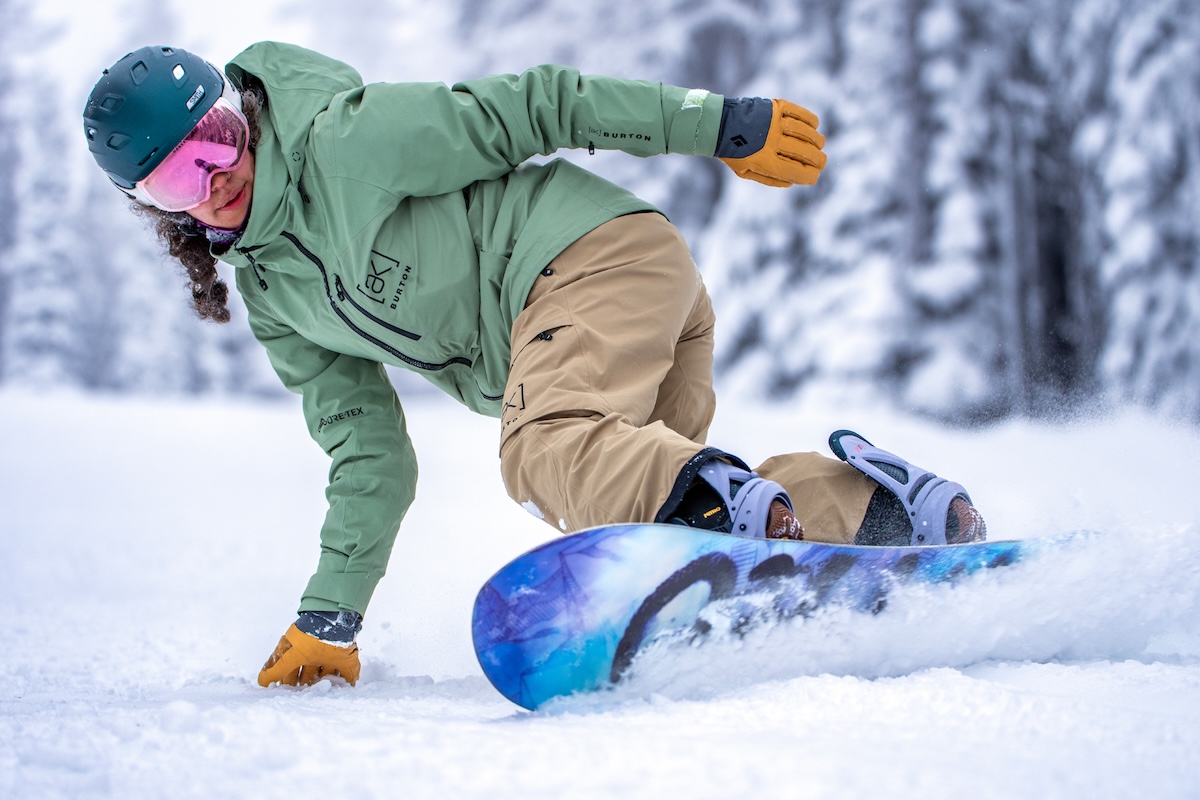
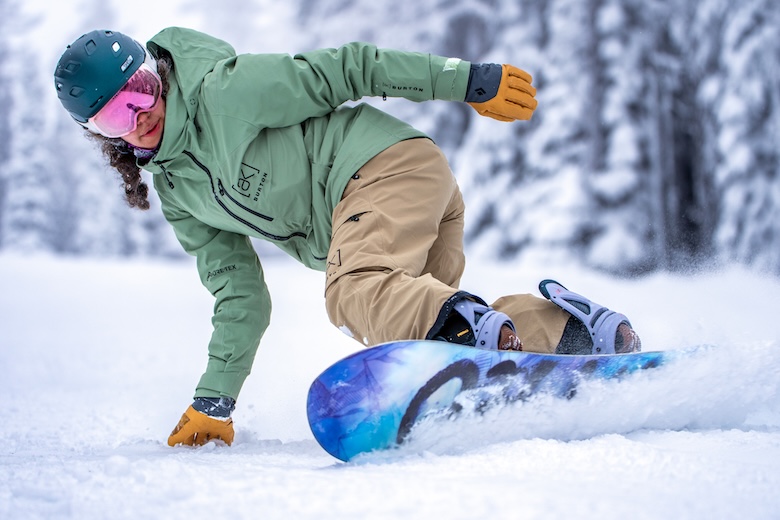
Switchback Travel (Jason Hummel)
From the beginning, style has been a key component of snowboarding culture and has largely influenced the sport's apparel as a result. Today, a good number of snowboarders still wear jackets and pants made by legacy brands like Burton, Volcom, and Jones, although mainstream names like Patagonia and Outdoor Research have also entered the space with freeride-inspired offerings. Below, we break down the best snowboard pants and bibs of the 2024/25 season, ranging from highly protective storm shells to budget-friendly resort designs and models that cross over from the ski world. For more background information, see our comparison table and buying advice below the picks. Finally, while this article includes picks for both men and women, we’ve also written a dedicated round-up of the best women's snowboard pants.
Editor's note: We updated this guide on November 11, 2024, to remove discontinued products, ensure all our picks represent the most current versions, and include more information about our team and testing practices. We also combed through the guide to ensure prices, colorways, and products were current at the time of publishing.
![Burton [ak] Gore-Tex Cyclic Pant](/sites/default/files/image_fields/Best%20Of%20Gear%20Articles/Snowboarding/Snowboard%20Pants/Burton%20%5Bak%5D%20Gore-Tex%20Cyclic%20Pant.jpg) Category: Shell
Category: Shell
Insulation: None
Waterproofing: 2L Recycled Gore-Tex
What we like: Hard-to-beat combination of technical performance, features, and style.
What we don’t: Expensive and some might not like the more relaxed, baggy fit.
Ever since Jake Burton Carpenter started building boards in his barn in the late 1970s, snowboarding and Burton have been practically synonymous. Now, the brand is a one-stop shop for everything from hardgoods to outerwear and lifestyle clothing, and their premium [ak] collection sets a high bar for technical performance. From this collection, the men’s Cyclic is our favorite all-around riding pant, combining top-notch waterproofing and a well-rounded feature set (including a great assortment of pockets) with Burton’s industry-defining style. For women, the Summit (also $420) builds off of the design of the Cyclic, adding a stretchy face fabric and tricot backer for extra mobility and warmth.
Along with style and features, a snowboard pant’s waterproofing and breathability are what differentiates one design from the next. In this case, the Cyclic uses recycled Gore-Tex (widely regarded as the best in the business) and full seam taping (some pants are only taped at critical seams) for protection. Additionally, a mesh liner and zippered inner thigh vents make breathability about as good as it gets for a 2-layer build. The Cyclic are also bluesign approved. Spending up for the 3-layer Freebird Stretch Bib ($670) will get you even better temperature regulation—great for splitboarders but maybe overkill for most resort-goers—while dropping down to Burton's $260 Ballast yields similar 2-layer Gore-Tex tech in a less premium design. But for the majority of snowboarders, the Cyclic hits the sweet spot of quality, performance, and style, earning it our top spot for the 2024/25 season.
See the Men's Burton [ak] Cyclic Gore-Tex See the Women's Burton [ak] Summit Gore-Tex
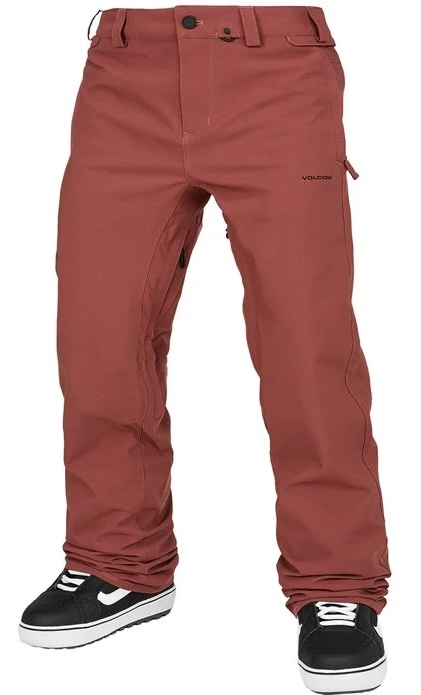 Category: Shell
Category: Shell
Insulation: None
Waterproofing: 2L V-Science
What we like: Uncompromised style and nice assortment of features.
What we don’t: Critical seam taping isn’t great for very wet conditions.
A lot of resort-focused snowboarders opt for a budget pant, and almost every major brand has thrown their hat into the ring with an entry-level offering. Most of these pants keep prices low (around $120 to $200) with trimmed-down feature sets and proprietary waterproof membranes (i.e., not Gore-Tex), but they’re fully serviceable for most inbounds riders. Within this category, the Volcom Freakin Snow Chino is our favorite option for men (our pick for women is the REI Powderbound Insulated—read about it in our article on the best women's snowboard pants), with subtle but classy looks, a stretchy twill face fabric for great comfort and mobility, and a 2-layer V-Science membrane that can stand up to most moderate precipitation and wind with ease (for reference, it has a 15K/15K waterproofing/breathability rating).
That said, despite the Freakin Snow Chino’s fully waterproof construction, it’s important to note that the pant (like most budget designs) is taped only at the critical seams. This means that it isn’t particularly well-suited for sustained and heavy snowfall, especially in warm and wet conditions. But the Volcom gets the job done on dry and cold days, and the relaxed fit eliminates extra material while still allowing ample room for layering underneath. Further, you get inner thigh vents, an adjustable waistband, and Volcom’s Zip Tech jacket attachment for keeping snow at bay. There’s no shortage of budget snowboard pants—Burton's $170 Covert 2.0 is another one of our top picks for those looking for a baggier style—but the Freakin Snow Chino puts it all together better than most.
See the Volcom Freakin Snow Chino
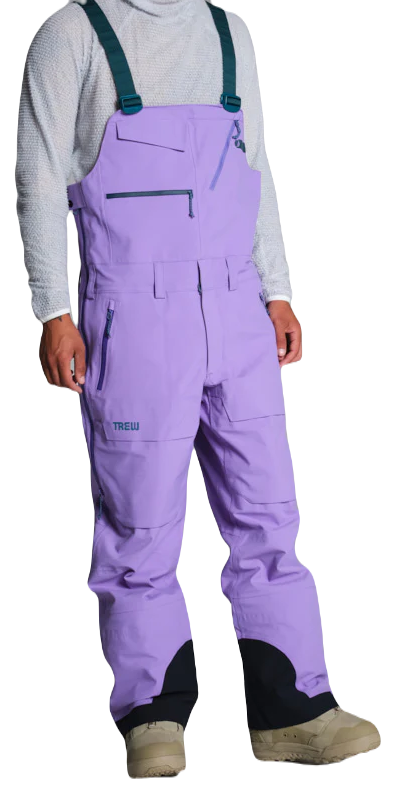 Category: Shell
Category: Shell
Insulation: None
Waterproofing: 3L PNW Primo
What we like: Fantastic quality, weather protection, and breathability.
What we don’t: Burly fabric is overkill in mild conditions.
There are a lot of reasons to opt for a bib over a pant: Not only are they stylish, but they provide great protection against snow and enough storage for all the essentials. Among the growing range of options, the well-built Trewth Bib Primo (and women’s Chariot Primo) is our top pick of the season. The design features Trew’s proprietary 3-layer PNW Primo construction that's reminiscent of premium Gore-Tex in both look and feel, full seam taping with reinforcements, smooth-operating water-resistant zippers, and bomber coverage that keeps even the wettest of snow at bay. Tack on a high-quality fit and finish (including an impressive offering of sizes and lengths), TechSteel cuffs and kick patches, and generous side vents that run from knee to chest, and the Trewth Bib is the full package for both resort and backcountry riders.
Compared to a 2-layer pant like the Cyclic above, the Trewth’s 3-layer construction eliminates the need for a hanging liner, which minimizes bulk and boosts overall breathability. The chest storage could perhaps be simplified (there are three pockets, which is a bit excessive, though we appreciate the 20mm D-ring in the right side pocket for clipping a beacon), and the burly fabric—while great on a storm day—might feel overkill in spring conditions. But minor gripes aside, the Trew Gear’s quality is second to none and lines up well with the $519 price tag. For a substantial step down in price, check out Trew’s Jefferson (and women's Astoria) bib, which features a more affordable 2-layer construction.
See the Men's Trew Gear Trewth Bib Primo See the Women's Trew Gear Chariot Bib Primo
 Category: Insulated
Category: Insulated
Insulation: 60g Thermogreen
Waterproofing: 2L H2No Performance Standard
What we like: Cozy warmth, great fit, and nice finishing touches.
What we don’t: Insulated pants lack versatility; not styled specifically for snowboarders.
Not everyone wants or needs insulated snowboard pants, but if you frequent the resort in particularly cold climates like the Northeast or the Rocky Mountains, they’re a nice option to have. Insulated snow pants typically use a thin but warm dose of synthetic fill (unlike down, synthetic continues to keep you warm when wet) that varies in terms of warmth and bulk. Among the myriad options, Patagonia's Powder Town is a standout pick: You get 60-gram Thermogreen fill (a fairly standard amount of insulation), sleek and clean styling that minimizes bulk, and a soft taffeta liner for great next-to-skin comfort (plus, all materials are 100% recycled). Tack on Patagonia’s H2No Performance Standard waterproof membrane, a PFC-free DWR, and a robust 75-denier face fabric, and the result is a pair of snowboard pants that can handle brutal mountain weather season after season.
Patagonia’s pants are built for both skiers and snowboarders, so you won’t find any snowboard-specific trimmings like cargo pockets or a baggy fit. If that's what you're after, check out the Burton Covert 2.0 Insulated below. But all the essentials are still present, including mesh-lined outer thigh vents, gaiters and scuff guards, and a jacket attachment at the waist. It is worth noting that insulated snow pants are a lot less versatile than a standard shell—you can add more warmth by selecting a thicker baselayer, but the built-in insulation means you can’t take warmth away. They also suffer in terms of breathability (after all, insulation is meant to trap heat). But for riders who desire an extra dose of warmth, the Insulated Powder Town is a great value. For a step up in quality, Patagonia also offers the Storm Shift pant, which features 2-layer Gore-Tex construction and a high-end fleece liner... Read in-depth women's Insulated Powder Town review
See the Men's Patagonia Insulated Powder Town See the Women's Patagonia Powder Town
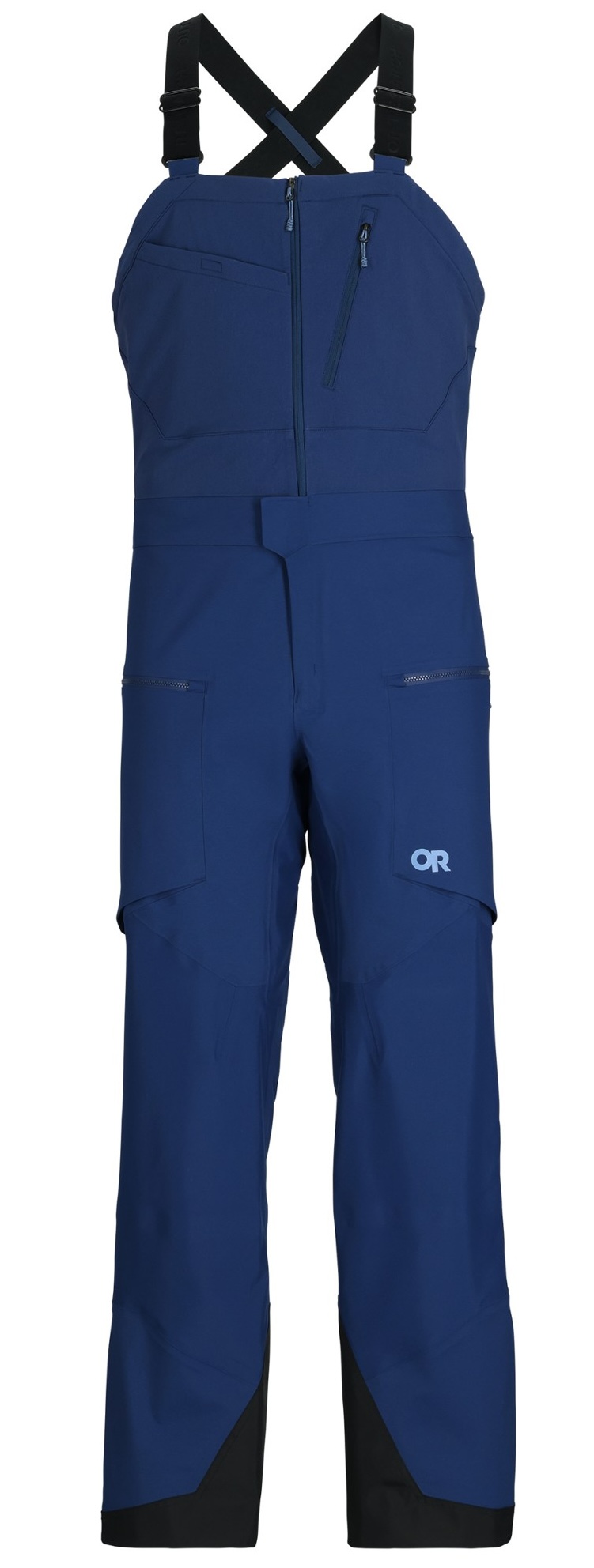 Category: Shell
Category: Shell
Insulation: None
Waterproofing: 3L AscentShell
What we like: Supple, softshell-like fabric is highly mobile, breathable, and comfortable.
What we don’t: Not durable or protective enough for consistent resort use.
While resort snowboarders get to bypass the hard work of uphill travel by getting onto a chairlift, splitboarders relish in it. But laying a skin track or a bootpack is no small task, and heat can build up in a hurry. For this reason, those headed to the backcountry typically prioritize breathability, and it doesn’t get much better than the Outdoor Research Skytour Bibs. OR’s AscentShell fabric is the key feature here: This best-of-both-worlds material stretches, breathes, and is remarkably quiet like softshell, while offering the waterproof protection of a hardshell. Tack on a softshell bib upper, gusseted crotch, articulated knees, and a trim, technical fit, and you get a highly mobile yet protective bib, ideal for heart-pumping backcountry adventures.
The Skytour is a great pairing for uphill enthusiasts, but the design does have some compromises. For one, the relatively thin (40D x 65D) AscentShell fabric doesn’t offer quite the wind and water protection of Gore-Tex—we’ve needed to wear thicker-than-normal baselayers on cold or windy days, and the bib is fairly quick to wet out in soggy Pacific Northwest conditions. Further, the cuffs are a tight fit over snowboard boots in walk mode, and unlike the Trewth’s 27 size options, the Skytour is only available in 15 sizes total (five sizes with three inseam lengths). But for snowboarders who like to earn their turns, the bib offers unbeatable performance, and the price is right, too. For a similarly stretchy and breathable design in an even lighter package, check out the Patagonia SnowDrifter ($399).
See the Men's Outdoor Research Skytour See the Women's Outdoor Research Skytour
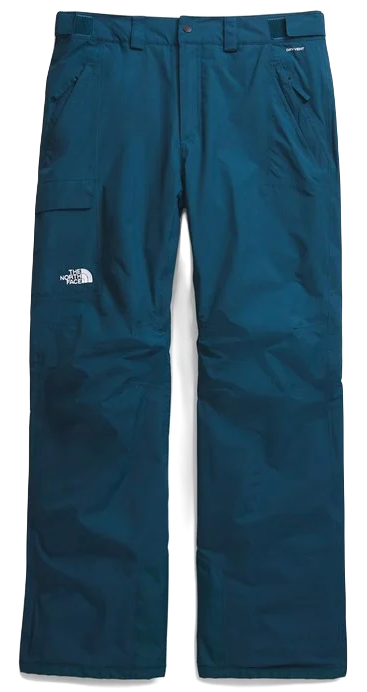 Category: Insulated
Category: Insulated
Insulation: 60g Heatseeker Eco
Waterproofing: 2L DryVent
What we like: Proven and tough resort design at a great price.
What we don’t: Style is not snowboard-specific; not everyone needs the added insulation.
For budget-seekers and those just getting started, The North Face Freedom is a great deal and one of the most popular pants on the slopes. The value is hard to beat: For just $220, you get a thick 2-layer construction that is super durable and blocks out wind and snow effectively. The 60-gram Heatseeker Eco insulation is a nice touch for those wanting a little extra warmth, and the venting system is surprisingly good for a budget pant. It’s true that the Freedom is a noticeable step down in quality from a design like the Burton Cyclic above, but it covers all the bases for many snowboarders at a very reasonable price.
That said, although the Freedom Insulated will do the trick for casual riders, performance-minded boarders likely will be left wanting more. To start, the fit is pretty generic, does not include articulated knees, and lacks the modern styling that many want (for a more trendy alternative, check out the Burton Covert 2.0 Insulated below). Additionally, it’s easy to overheat with the cheap waterproofing technology, and while we like the zippered vents, their placement along the inner thigh (and the accompanying waterproof flaps) creates extra bulk. But we keep coming back to value: The Freedom pants are a proven choice with a surprisingly long lifespan and they undercut most of the competition price-wise by a sizable margin. It’s worth noting that TNF makes a non-insulated pant and bib version of the Freedom, both of which also get rave reviews for their combination of style, performance, and price... Read in-depth Freedom Insulated review
See the Men's TNF Freedom Insulated See the Women's TNF Freedom Insulated
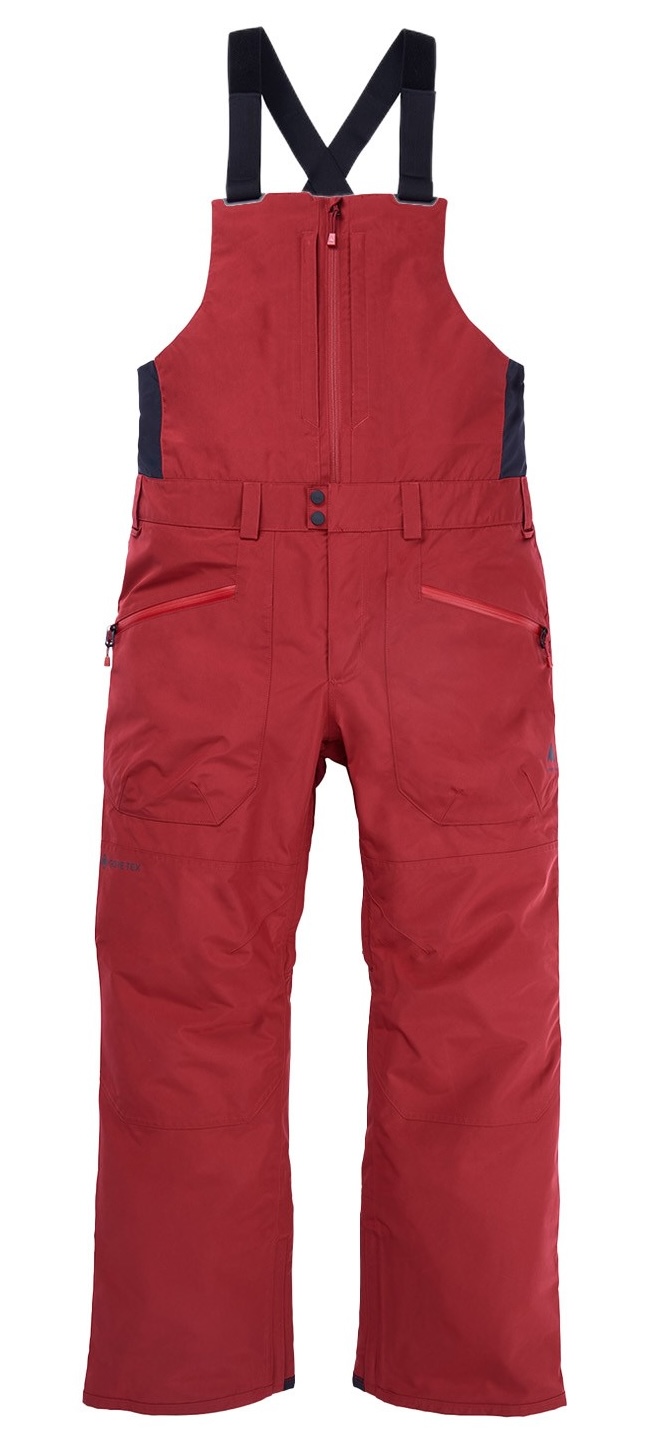 Category: Shell
Category: Shell
Insulation: None
Waterproofing: 2L Gore-Tex ePE
What we like: Highly durable, good looks, and quality protection.
What we don’t: No drop seat and doesn't come in short and tall sizes.
No matter the resort, you’re bound to see more snowboarders wearing Burton than any other brand. The Reserve Bib is one of their most popular offerings, so much so that it’s made in both Gore-Tex and non-Gore-Tex varieties (the latter uses Burton's in-house waterproofing and is $80 cheaper). The Reserve GTX here packs in a ton of quality for the price: You get a 2-layer construction along with full seam taping and burly 150-denier face fabric (for comparison, the Cyclic above is 70D) for just $360—comparable offerings like the 686 GTX Stretch Dispatch below will cost over $100 more. If you’re in the market for a robust resort-specific bib, the Reserve (and women’s Avalon) should be toward the top of your list.
However, as we mentioned previously, 2-layer constructions do not get high marks for breathability, and the Reserve’s burly fabric certainly doesn’t help. If you like to earn your turns or charge hard in and out of the ropes, a 3-layer design like the Trew Gear above will do a much better job regulating temperature, and the 686 Dispatch below also excels with more breathable fabrics and cross-venting options. Further, the Reserve does not include a drop seat (notably, the women’s Avalon does), which can make bathroom breaks a bit of an ordeal. And like many bibs here, it isn’t offered in short or tall sizes (though the non-GTX version is). But you’d be hard-pressed to find a better combination of performance, durability, and style at this price point, and there's a reason the Reserve is one of the best-selling bibs among snowboarders.
See the Men's Burton Reserve Gore-Tex 2L See the Women's Burton Avalon Gore-Tex 2L
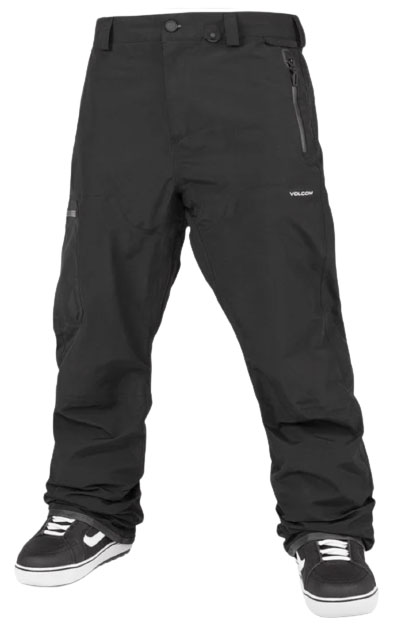 Category: Shell
Category: Shell
Insulation: None
Waterproofing: 2L Gore-Tex
What we like: A Gore-Tex pant at an excellent price point.
What we don’t: A couple of fit and finish issues.
Volcom excels in the budget category (as seen with the Freakin Snow Chino above), but the L Gore-Tex pant here is a very competitive mid-range offering. Combining a premium 2-layer Gore-Tex construction with a breathable liner and inner thigh vents, the L will keep you dry on wet lift rides but isn't prone to overheating on spring-like days. Serious riders will also appreciate the articulated fit, which makes for a stylish yet functional freeride design that won't weigh you down. Tack on features like cargo pockets, extra stitching at the inner rise, and hem reinforcements, and it's clear that the L is a thoughtfully built snowboard pant through and through.
You won’t find a lot of Gore-Tex in the mid-$300 price range, making the Volcom L one of the better values out there (it offers similar protection to the Cyclic above for a whopping $70 less). But the finer details aren't as well-sorted: The single button closure has a tendency to come undone, the white mesh lining on the thigh vents is reminiscent of cheap gym shorts, and—unlike the Cyclic—you don’t get the option for a short or tall inseam. That said, we think the Volcom hits a nice sweet spot for price-conscious riders looking for a step up from an entry-level design. On the women's side, Volcom’s Aston sports a similar build with 2-layer Gore-Tex and retails for $320.
See the Men's Volcom L Gore-Tex See the Women's Volcom Aston Gore-Tex
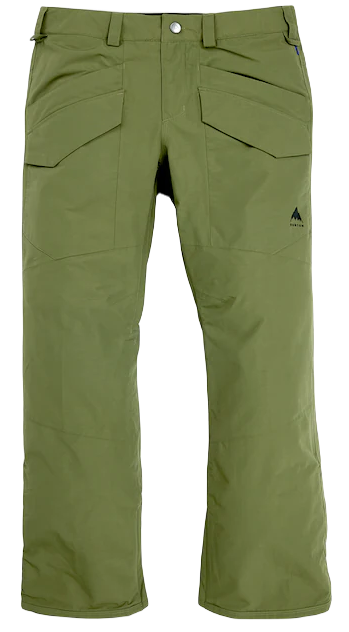 Category: Insulated
Category: Insulated
Insulation: 40g Thermolite
Waterproofing: 2L Dryride Durashell
What we like: A stylish insulated pant at a great price.
What we don’t: Not as weather protective or durable as the Patagonia Powder Town.
For value seekers on the hunt for an insulated pant, it doesn’t get much better than the Burton Covert 2.0 Insulated pant. Priced right at only $200, the Covert boasts a warm layer of 40-gram Thermolite insulation wrapped up in Burton's 2-layer Dryride membrane with fully taped seams. A fairly minimalist feature set and simple fit keep costs low, but the Burton is still fully functional for inbounds use with microfleece handwarmer pockets, stylish cargo and thigh pockets, and inner thigh vents. And with a burly face fabric, the Covert 2.0 Insulated is built to withstand many seasons of demanding resort use.
If you’re deciding between the Covert and Patagonia’s Insulated Powder Town above, there are a few things to keep in mind. In our experience, Burton’s Dryride waterproofing and breathability is no match for Patagonia’s more premium H2No, and won't hold up in sustained wet weather. What's more, the Covert isn't quite as warm with 40-gram insulation compared to the Powder Town’s 60-gram insulation. On the other hand, the Covert is $69 cheaper and has a snowboard-inspired fit and aesthetic, which many resort riders will appreciate. In the end, we’d recommend the Powder Town for true winter conditions and those who get out a lot, but the Covert 2.0 is perfectly serviceable for most recreational snowboarders.
See the Burton Covert 2.0 2L Insulated
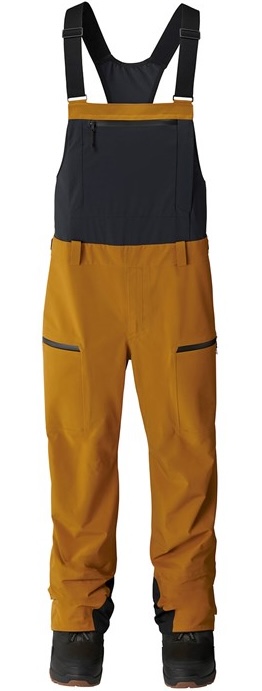 Category: Shell
Category: Shell
Insulation: None
Waterproofing: 3L polyester
What we like: A versatile bib from a core snowboard brand.
What we don’t: Sub-par protection and durability for serious use; sizing can be tricky.
Built from the ground up by legendary freerider Jeremy Jones, Jones Snowboards makes some of the best boards in the business. The Truckee, Calif.-based brand expanded its lineup to include outerwear fairly recently, and the Shralpinist Stretch Recycled here is their versatile bib offering for both resort and backcountry riding. We wore the Shralpinist Stretch kit all of last winter, logging countless days in everything from mid-winter squalls to fog, light rain, and bluebird conditions. And the bib delivered: The combination of stretch polyester below the belt and a stretch-woven softshell upper provides great mobility and comfort for active riders, and it walks that fine line between protection and breathability for days that include both lift riding and sidecountry slogs.
Jones lightly updated the Shralpinist in 2024, swapping out the 40-denier polyester for thicker 70-denier. This is a big improvement from the outgoing version, which soaked up water more quickly than our friends’ Gore-Tex bottoms and was noticeably permeable to wind (we had to swap in a warmer baselayer on particularly cold days). Despite the upgrade, we still recommend stepping up to a Gore-Tex design—like Jones’ own Shralpinist Recycled Gore-Tex ePE Bibs ($725)—for heavy use and particularly wet conditions. But for mostly dry climates or those who dip in and out of bounds, we really like the Stretch’s breathability measures, and all the additional features we look for are there, including outer thigh vents, adjustable shoulder straps, and a practical pocket layout. And a note on sizing: Our 6-foot-tall tester maxed out the size medium bibs, but the large was too baggy; we hope Jones adds more inseam lengths (or greater adjustability) in iterations to come.
See the Men's Jones Shralpinist Stretch Bib See the Women's Jones Shralpinist Stretch Bib
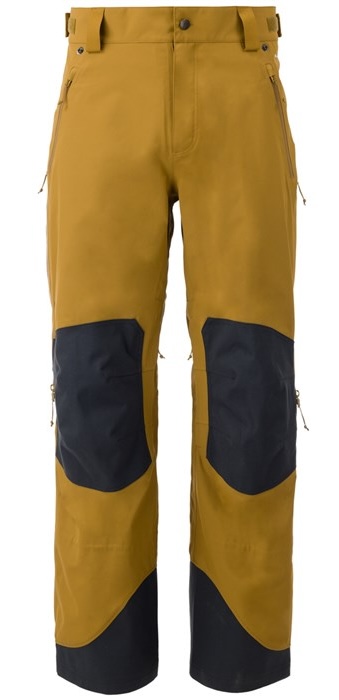 Category: Shell
Category: Shell
Insulation: None
Waterproofing: 3L Surface
What we like: Great durability and breathability for hard chargers.
What we don’t: Surface membrane isn’t quite as premium as Gore-Tex.
Flylow Gear flies a little under the radar compared to bigger names like Burton and The North Face, but the Chemical (and women’s Nina) pants are a solid offering from the Colorado-based brand. Built for both skiers and snowboarders, this is a super tough design with a 3-layer construction, 1,000-denier reinforcements in high-wear areas like the cuffs, and waterproof zippers. In addition to the impressive level of protection, the pants also ventilate well, and you can release hot air in four places: two zippered vents along the inner thigh and two large vents along the outside of your legs. All told, it’s a well-built design and a great option for spring days or those who tend to run particularly warm.
It's worth noting that the Chemical hits a similar price point as our top-ranked Burton Cyclic above. Where do the two differ? With a 3-layer build and crossflow venting, the Chemical gets the clear edge in heat-dumping capabilities, although you give up the trusted protection of Gore-Tex (Flylow’s Surface membrane is nevertheless a quality performer). And while many resort riders will likely prefer the Burton's more subdued styling, the Chemical's baggy fit scores high marks among freeride enthusiasts. It’s also available in both short and tall inseam options. If you charge hard and want a burly yet breathable pant that won't hold you back, the Flylow is a great choice. And if the Chemical’s styling appeals to you, it’s worth checking out Flylow’s full lineup of bibs and pants, from the budget-friendly Patrol Pant ($200) to the high-end Baker Bib ($430) below.
See the Men's Flylow Gear Chemical See the Women's Flylow Gear Nina
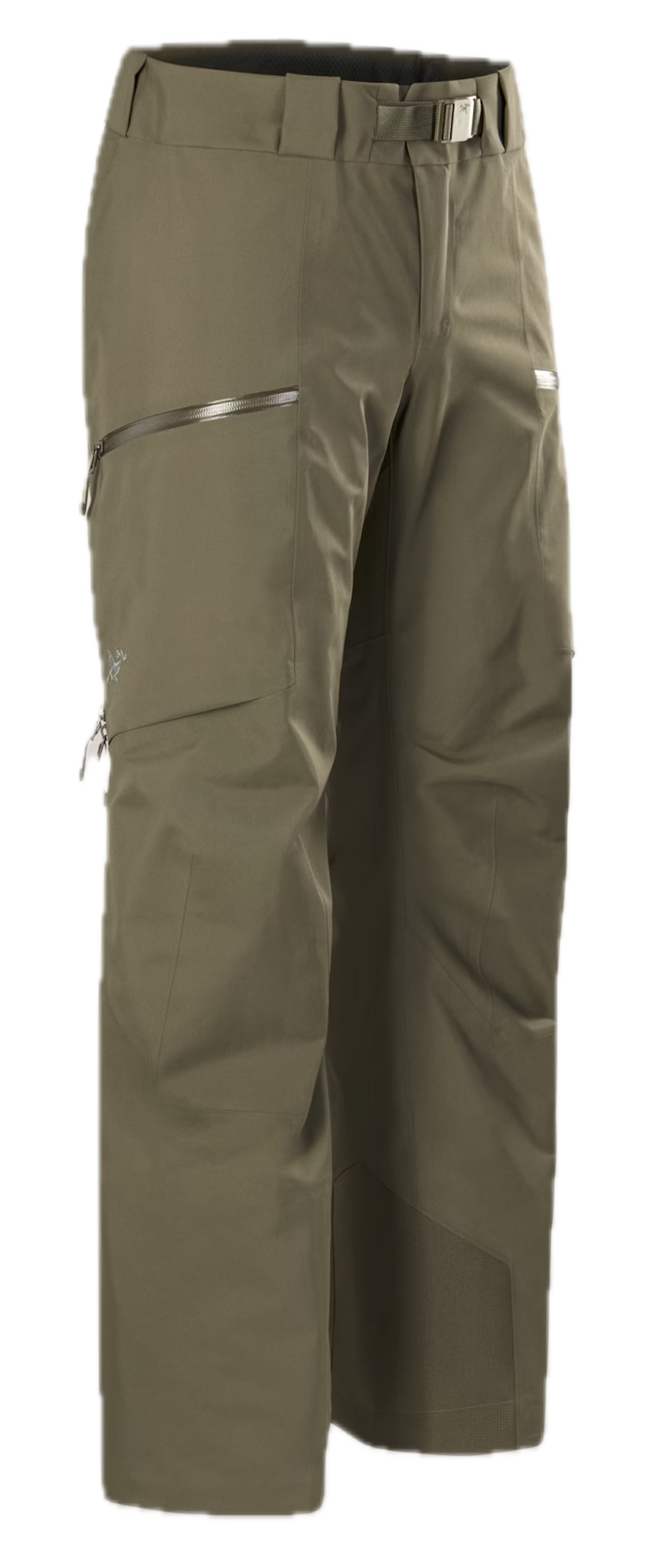 Category: Shell
Category: Shell
Insulation: None (light flannel backer)
Waterproofing: 3L Gore-Tex
What we like: Bomber 3-layer build that excels both at the resort and in the backcountry.
What we don’t: Expensive, runs small, and the tighter, athletic fit won't be for everyone.
Based in British Columbia’s Coast Mountains, Arc’teryx is no stranger to bad weather. Combine that with a truly impressive dedication to sweating the small details, and the brand consistently delivers premium, top-performing outerwear. Their go-to pant for both resort and backcountry riders is the Sabre (and women's Sentinel), which features bomber yet light 80 denier, 3-layer Gore-Tex waterproofing. This translates to exceptional protection and improved breathability compared to the 2-layer designs that dominate the market. In addition, you get a brushed liner for extra warmth and next-to-skin comfort and generous side zips for dumping heat on the skin track.
So with that glowing review, why do we rank the Sabre here? The easiest answer is cost: Most resort-goers don’t want to spend $600 on a pair of pants, nor do they need to (2-layer construction is perfectly serviceable for in-bounds riding). Second, the Sabre isn't specifically built for snowboarders, resulting in a more technical style that lacks features like cargo pockets and extra butt protection. Third, if you’re looking for a premium 3-layer design, you can save over $200 with the Flylow Gear Chemical above. And lastly, the Sabre's fit won't be for everyone: The bottom half is fairly roomy, but the upper half has an oddly slender, athletic fit that can hinder movement for some body shapes. It would be wise to consider sizing up or checking out the relaxed fit version. All nitpicks aside, this is one of the best snow pants money can buy (it’s our favorite ski pant this year) and is a great choice for those who split their time between the backcountry and the resort. If the Sabre Pants work for you, they’re a winning design year after year (and there's even a bomber bib version, too)... Read in-depth Sabre Pant review
See the Men's Arc'teryx Sabre Pant See the Women's Arc'teryx Sentinel Pant
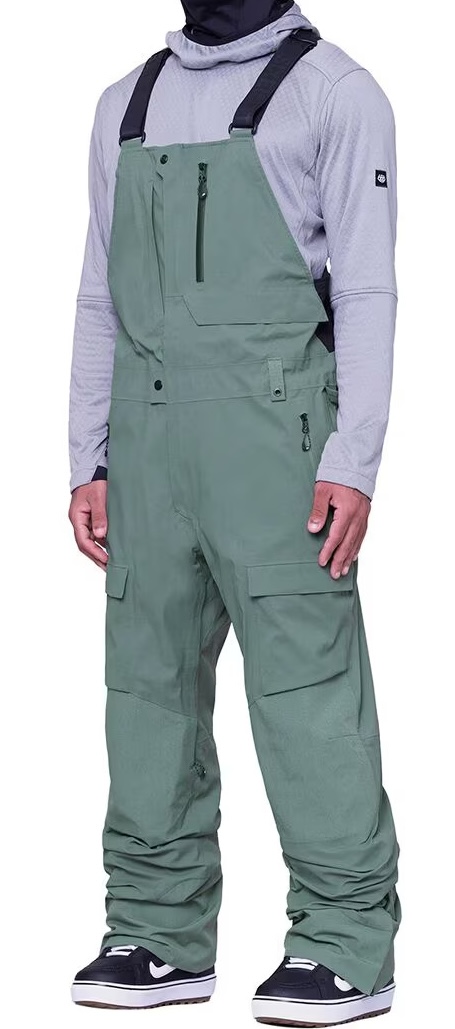 Category: Shell
Category: Shell
Insulation: None
Waterproofing: 2L Gore-Tex
What we like: A high-end and stretchy resort bib built specifically for snowboarders.
What we don’t: The thick shell and hanging liner are too bulky for any serious hiking.
Founded in the early ‘90s as part of a University of Southern California class project, 686 offers a large selection of skate and snowboard apparel. While often thought of as a go-to for budget snow jackets and pants, their premium Gore-Tex offerings are not to be missed. The Dispatch Bib is one of our favorites with a 2-layer Gore-Tex construction and stretch-nylon face, along with all the bells and whistles we look for in a high-end snowboard bib: a Recco patch, Boa-compatible gaiters, a stretchy softshell panel at the lower back, burly knee and cuff patches, and a plethora of pockets. If you’re on the hunt for a high-quality and protective bib built specifically for snowboarders, the Dispatch is a great place to land.
Many snowboarders will be drawn to cult brands like 686 and Jones, but there are a number of differences that set the Dispatch apart from the Shralpinist Stretch above. Because of its burly 2-layer construction and hanging liner, the Dispatch isn’t our first choice for hiking or particularly active riders—we’d recommend the lighter-weight and more breathable 3-layer Shralpinist instead. On the other hand, the Gore-Tex waterproofing and thicker 155-denier face make the Dispatch the more confidence-inspiring choice, whether you’re riding through deep powder, dodging trees and branches, or caught in a storm. And when you do build heat, breathability isn’t half bad with the stretchy shell and cross-venting, which includes small vents both at the inner thighs and hips. All told, resort riders will find a lot to like about the 686 Dispatch Bib, and it doesn’t hurt that it’s a great-looking design.
See the Men's 686 GTX Stretch Dispatch See the Women's 686 GTX Stretch Dispatch
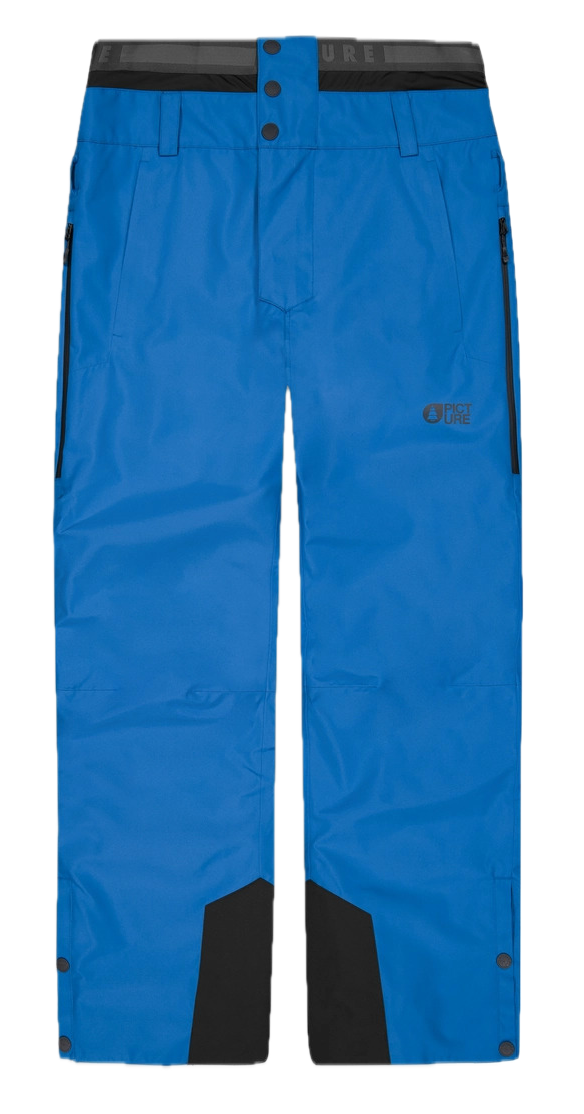 Category: Insulated
Category: Insulated
Insulation: 40g Recycled Thermal STD
Waterproofing: 2L DryPlay
What we like: Sustainable materials and well-sorted features.
What we don’t: Not everyone will love the unique Euro styling.
Picture Organic is another brand building up a small but loyal following. With a commitment to sustainability at the helm, their products are a highlight reel of organic and recycled materials, PFC-free water repellent treatments, and ethical production practices. The Object here is representative of their pant collection as a whole, combining excellent build quality, a protective in-house membrane, and unique and thoughtful styling. You also now get a thin layer of 40-gram insulation, making it a nice choice for most wintery days on the slopes. Oh, and did we mention the latest version's shell fabric is made from repurposed sugarcane waste?
A lot of snowboard pants can be fairly bland, so kudos to Picture for experimenting and putting some serious effort into their designs. Not everyone will love the high waist of the Object (and women's Exa), but it does a great job keeping snow out and folds down when not in use. And we’re big fans of the top-of-thigh vents, which catch a breeze much better than the more standard inner-thigh variety. From the silicone reinforcements and I-Fit system at the hem for rolling the cuffs back to the waterproof zippers and fully taped seams, the rest of the Object is well-built with a keen attention to detail. If you’re not put off by the flashy Euro styling, it’s a great value at $230 and a nice intro to what Picture Organic is all about.
See the Men's Picture Organic Object See the Women's Picture Organic Exa
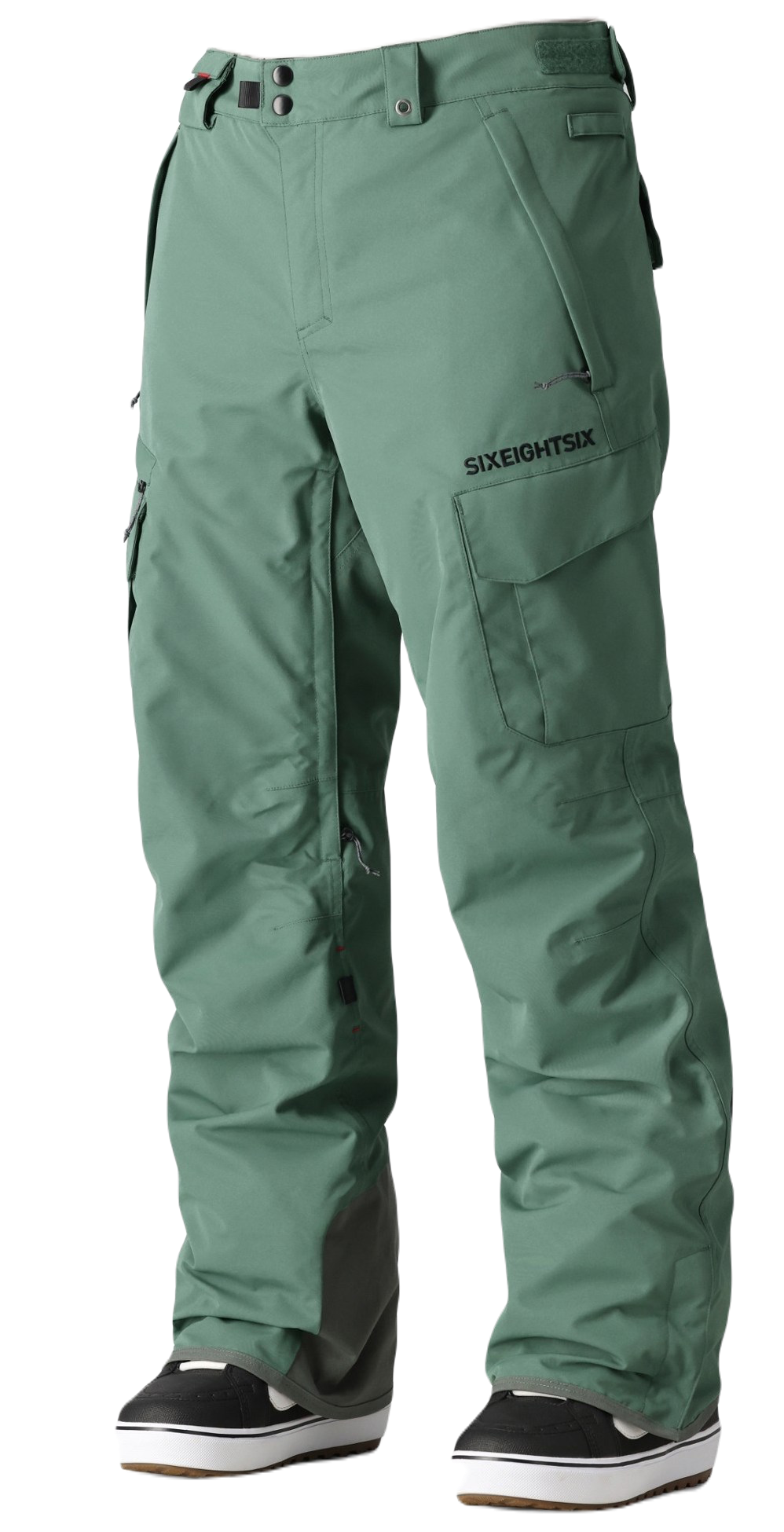 Category: Insulated
Category: Insulated
Insulation: Fleece
Waterproofing: 2L infiDRY
What we like: 3-in-1 value with a durable, long-lasting shell.
What we don’t: In most cases, we’d advise against a 3-in-1 design.
3-in-1 pants have a lot of appeal for those new to snowboarding: In one fell swoop, you can get an insulated snowboard pant, a shell, and a cozy fleece liner for wearing around the lodge. It’s a versatile purchase that gives you a lot of options, whether you’re riding in deep winter conditions in Vermont or on a bluebird spring day in the PNW. 686’s Smarty has long been a popular option amongst 3-in-1 enthusiasts, with a durable and protective shell (this model is made with proprietary infiDRY, although 686 also offers a GTX version) and a cozy fleece midlayer that zips in and out.
That said, we’re not huge fans of 3-in-1 pants. They’re not as effective as standard insulated designs at trapping and maintaining warmth, and the additional zipper is cumbersome and unsightly when not connected. What’s more, the Smarty, in particular, has a fairly cheap feel, with a plasticky—albeit durable—shell and a relatively busy feature set. If you’re just getting started, we’d instead recommend buying a simple shell pant and a few separate layering options, including a thin baselayer and a fleece or merino midlayer (especially if you anticipate riding in cold conditions). But the 686 has its place for no-fuss boarders who want the convenience of a 3-in-1 purchase and don't mind the tradeoffs.
See the Men's 686 Smarty 3-in-1 Cargo See the Women's 686 Smarty 3-in-1 Cargo
 Category: Shell
Category: Shell
Insulation: None
Waterproofing: 3L Surface
What we like: A bomber resort-focused bib that can handle abuse.
What we don’t: Heavy, lacks stretch, and women's equivalent isn't as robust or well-featured.
The Flylow Baker (and women's Foxy) is the last bib to make our list, but it’s by no means a slouch. With a sleek 3-layer construction, long side vents, and cuff and knee reinforcements, this bib exudes quality and is a true standout. A roomier fit and a wide assortment of colorways make this a great pick for snowboarders in both the sidecountry and resort. Rounding out the features is a healthy array of storage options, including a thigh pocket that's accessible with a harness on, two zippered and one snap chest pocket, two zippered hand pockets, and a rear zippered pocket (the women's Foxy differs slightly with two chest pockets, a chest kangaroo pouch, and one pleated and two zippered thigh pockets).
The Flylow Baker's 150-denier nylon with 1000-denier cuffs and knee reinforcements (only 100D and 500D, respectively, on the Foxy) make for a burly and heavy pant. It also lacks the stretch you get with slightly more expensive alternatives like the Jones Shralpinist Stretch and 686 Gore-Tex Stretch Dispatch above, which we see as one of its main downsides—we’ve grown fond of stretchy snowboard apparel both for its comfort and mobility. But the Baker and Foxy are, nevertheless, a great option for those who spend more time at the resort with occasional hikes. We’re big fans of the technical yet mellowed-out style.
See the Men's Flylow Gear Baker Bib See the Women's Flylow Gear Foxy Bib
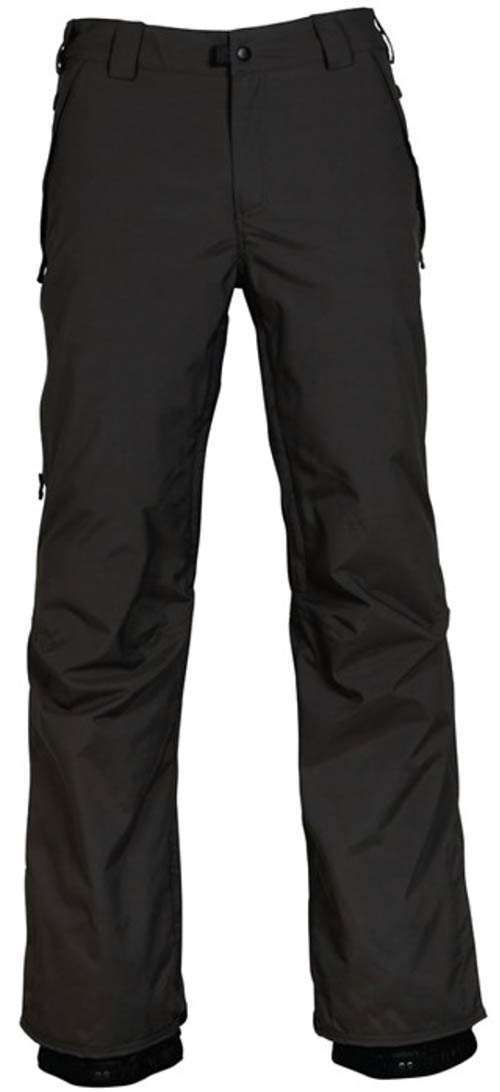 Category: Shell
Category: Shell
Insulation: None
Waterproofing: 2L infiDRY 10K
What we like: Bargain-basement price and snowboard-specific feature set.
What we don’t: Not as waterproof or breathable as more premium designs.
If you’re just dipping your toes into snowboarding, there’s no need to spend big on a premium pant. We’ve listed a number of sub-$200 options above, but those looking for a truly bargain-basement design can save even more with the 686 Standard here. For just $120 (and often found on sale), the Standard comes equipped with most of the features recreational snowboarders look for, including boot gussets and gaiters, reinforced patches at the hem, inner leg vents, and a decent assortment of pockets. Tack on a casual aesthetic and unobtrusive fit, and there’s no denying that 686’s most basic pant offers pretty good bang for your buck.
All that said, it's important to recognize what you give up with such a budget design. Most notably, waterproofing and breathability (both rated at 10K) are a step down from some of the more premium materials above (though 686 doubled the rating for 2024/25, from 5K to 10K). Without going into too much detail (we discuss waterproofing ratings in our buying advice below), the main takeaway is that if you're spending a lot of time sitting (or falling) in snow, spending an additional $55 for the Volcom Freakin Snow Chino above will earn you 15K waterproofing, which will be worth it for most. But if your main concern is cost, the 686 is the cheapest option here and will realistically still get the job done.
See the Men's 686 Standard Shell See the Women's 686 Standard Shell
| Pant | Price | Category | Insulation | Waterproofing | Seams |
|---|---|---|---|---|---|
| Burton [ak] Cyclic Gore-Tex | $420 | Shell | None | 2L Gore-Tex | Fully taped |
| Volcom Freakin Snow Chino | $175 | Shell | None | 2L V-Science | Critically taped |
| Trew Gear Trewth Bib Primo | $519 | Shell | None | 3L PNW Primo | Fully taped |
| Patagonia Insulated Powder Town | $269 | Insulated | 60g Thermogreen | 2L H2No | Fully taped |
| Outdoor Research Skytour Bibs | $429 | Shell | None | 3L AscentShell | Fully taped |
| The North Face Freedom | $220 | Insulated | 60g Heatseeker | 2L DryVent | Fully taped |
| Burton Reserve Gore-Tex 2L Bibs | $360 | Shell | None | 2L Gore-Tex | Fully taped |
| Volcom L Gore-Tex | $350 | Shell | None | 2L Gore-Tex | Fully taped |
| Burton Covert 2.0 2L Insulated | $200 | Insulated | 40g Thermolite | 2L Dryride | Critically taped |
| Jones Shralpinist Stretch Bibs | $475 | Shell | None | 3L polyester | Fully taped |
| Flylow Gear Chemical | $365 | Shell | None | 3L Surface | Fully taped |
| Arc'teryx Sabre Pant | $600 | Shell | None (flannel backer) | 3L Gore-Tex | Fully taped |
| 686 Gore-Tex Stretch Dispatch | $500 | Shell | None | 2L Gore-Tex | Fully taped |
| Picture Organic Object | $230 | Insulated | 40g Thermal STD | 2L DryPlay | Fully taped |
| 686 Smarty 3-in-1 Cargo | $230 | Insulated | Removable fleece | 2L infiDRY 10K | Fully taped |
| Flylow Gear Baker Bib | $430 | Shell | None | 3L Surface | Fully taped |
| 686 Standard Shell | $120 | Shell | None | 2L infiDRY 10K | Critically taped |
The Switchback Travel team loves storms and snow, especially deep riding conditions. Whether that means getting after it at the resort or touring in the backcountry, having pants and bibs you can trust is part of creating a great experience. Former senior editor Jenny Abegg worked on this guide since its inception in 2021, starting with a handful of carefully considered picks. Jenny calls northern Washington home and can be found chasing snowy peaks and trails for as long as the weather allows. Editor-in-chief Penney Garrett joined the crew in early 2024 and took the reins on this guide. Penney calls the Lake Tahoe area home, where there is almost limitless riding and deep snow. Collectively, this dedicated team brings an impressive number of decades of experience to the table. No matter what your objective is, our picks above and advice below will help you find the best way to stay warm, dry, and comfortable while shredding the slopes.
Our lineup includes our recommendations for snowboard pants chosen based on hundreds of hours of research, hands-on testing, and feedback from our readers and community. Testing these pants involves assessing the details of materials and insulation, noting all aspects of fit and layering ability, and scrutinizing overall durability, weight, size, and packability where appropriate. We also consider any helpful features, sustainable innovations, and whether each pant is made in a women's version and, if it is, what key features might be different. As we continue testing into the season, be sure to check back as we update the list above to showcase the best performers.
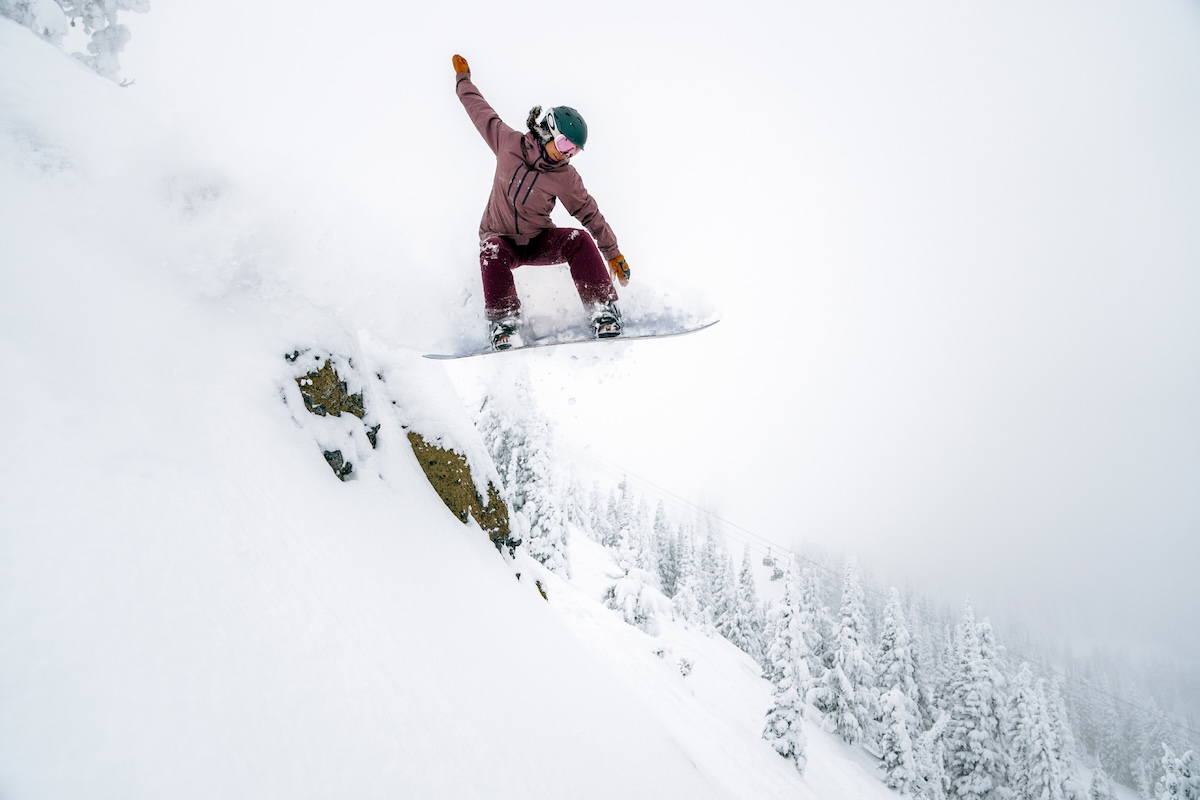
Shell
Snowboard pants can be divided into two general categories: shell and insulated. Shell pants are the most versatile option for most riders, featuring a simple 2- or 3-layer hardshell exterior (more on this below). Their lack of insulation means you can tune your layers underneath based on conditions: Go with a light baselayer for spring days or throw on a thick fleece pant to stay warm in cold temperatures. Shells are also the most breathable option, particularly those of the premium 3-layer variety. Shell pants are a great option for most days on the slopes, but especially in mild conditions (such as those found in the PNW) or those who tend to run warm. Top shells from our list include Burton’s [ak] Cyclic, the Trew Gear Trewth Bib, and Volcom’s L Gore-Tex.
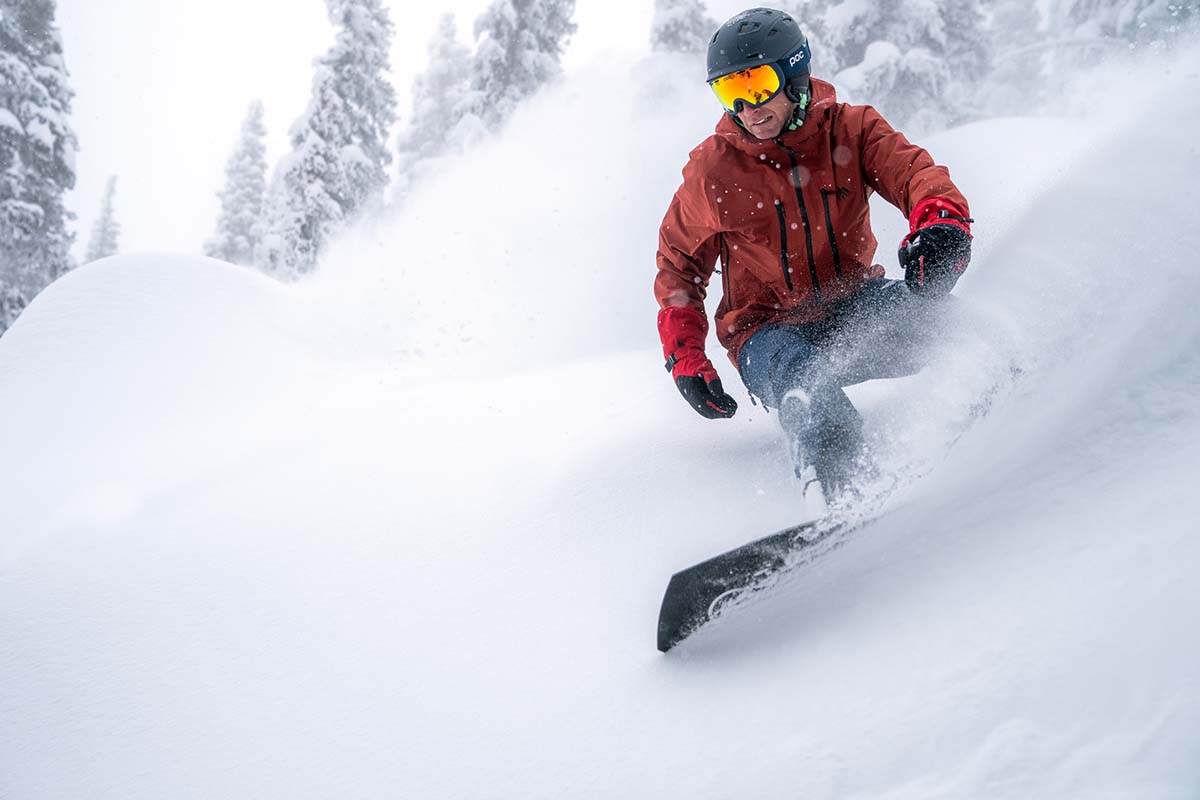
Insulated
Given the stop-and-start nature of snowboarding—sitting on the lift, strapping in and out of bindings, and hanging out in the park—some resort riders will consider a pant with some form of insulation. The vast majority of insulated pants use synthetic fill due to its affordability and ability to keep you warm even when wet (unlike goose or duck down, which clumps up). Warmth varies between models, and the picks above range from 40-gram to 60-gram fill weights. Finding your sweet spot will depend on the conditions you get out in, your riding style (aggressive or casual), and if you’re prone to running hot or cold. We highly recommend erring on the side of under-insulating, as it’s far easier to add layers underneath than deal with roasting in a too-warm pant.
While we love the security and comfort of slipping on an insulated pant in cold weather, there’s no denying that it comes at the tradeoff of breathability and versatility. The built-in insulation means the pant will grow swampy in a hurry, and you can only release so much heat with thigh vents. But if you run cold or ride in consistently frigid temperatures, a good case can be made for an insulated model. Some of our favorites include Patagonia’s Insulated Powder Town, The North Face’s Insulated Freedom, and the Burton Covert 2.0 Insulated. Finally, 3-in-1 designs like the 686 Smarty toe the line between shell and insulated pants, giving you the option for both configurations in addition to a standalone midlayer.
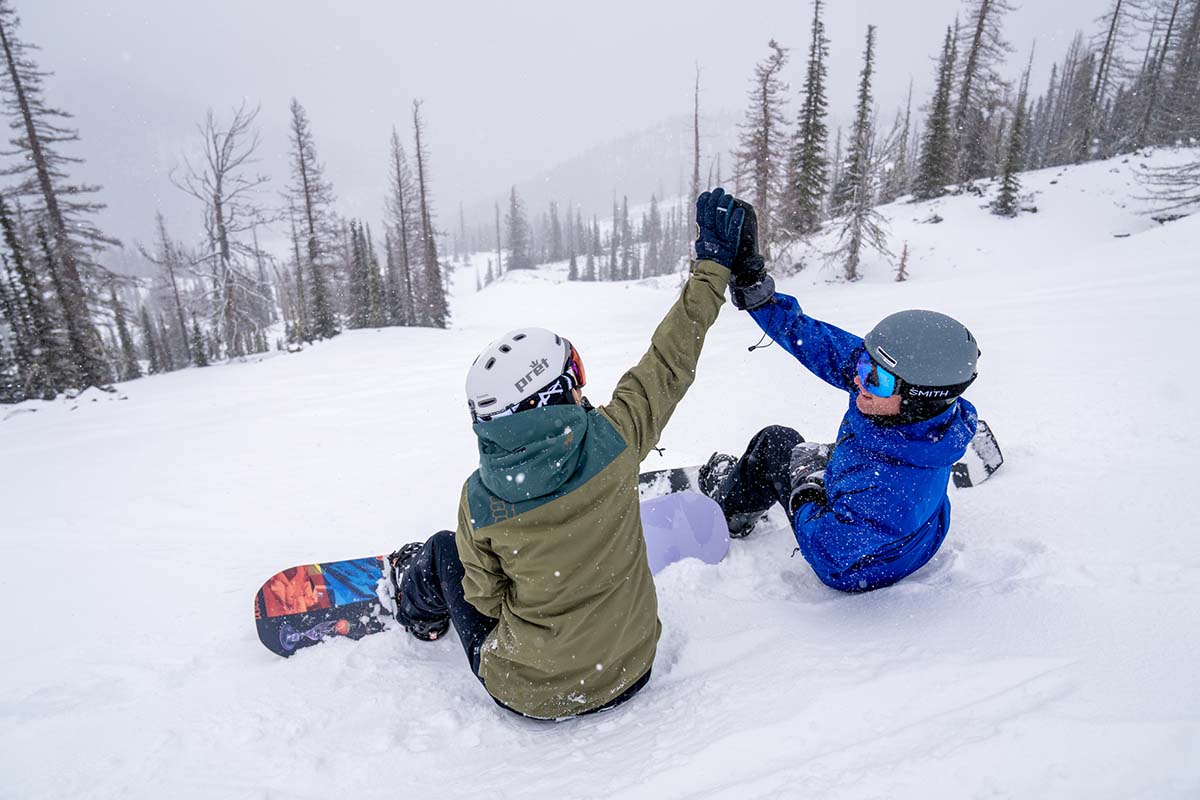
In researching snowboard pants, you’ll consistently find two numbers being marketed heavily: A waterproof rating (usually listed in millimeters) and a breathability rating (provided in grams). For waterproofing, many manufacturers use what’s commonly referred to as a static-column test: A piece of the pant’s shell fabric is set below a 1-inch-diameter tube, which is then filled with water until the fabric begins to leak. The height of the water at that point of failure is its rating. The breathability test is more convoluted and less standardized, but it's designed to measure how much water vapor travels from the inside to the outside of the fabric over a 24-hour stretch.
What should be immediately clear from both of these tests is that they don’t perfectly simulate winter conditions, and we don’t recommend relying on them too heavily when selecting a pant. In particular, don't waste too much focus on the breathability rating: There isn’t an established procedure to compare products, and the test is done in a controlled lab environment (in other words, not out in the snow). There is some value in the static-column rating—a higher number will typically lead to better waterproofing—but plenty of other factors come into play, including the quality of the membrane, DWR coating, fabric denier, and seam taping. We provide more details on waterproofing and breathability in the sections below.
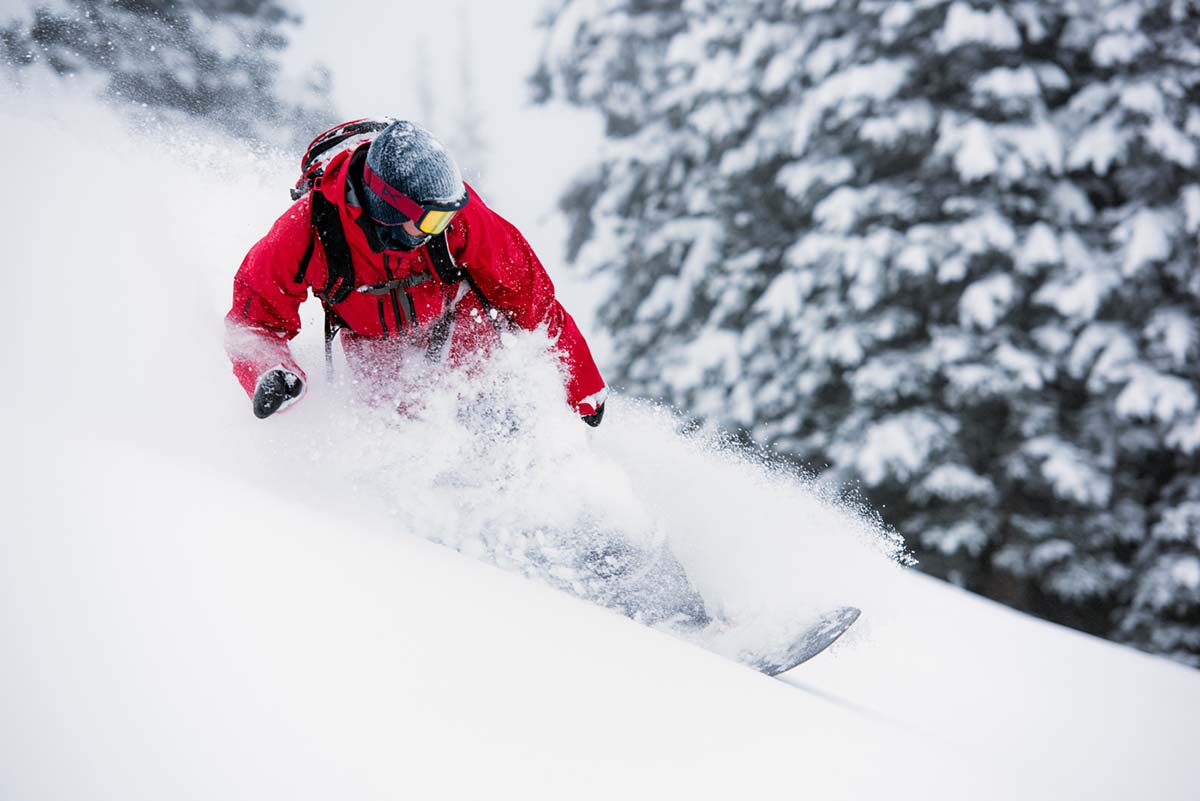
Construction
Waterproof ratings can be the first clue towards discerning the level of protection a pant will provide, but it’s important to dig a bit deeper into the specs. The first thing we look for is the quality of the waterproof construction, and in terms of protection and longevity, it’s hard to beat Gore-Tex. In both their mid-range 2-layer and lighter and more breathable 3-layer varieties, we’ve found Gore-Tex to be reliably wind and waterproof even in harsh and wet conditions. To save money, many manufacturers utilize in-house designs, and proven options here include Patagonia’s H2No and Outdoor Research’s AscentShell. Stepping down to budget-oriented models in the $100 to $200 price range gets you a noticeable drop in quality. These pants will provide sufficient protection in moderate and dry conditions, but the lower-end builds aren’t as long-lasting or reliable on particularly gnarly days.
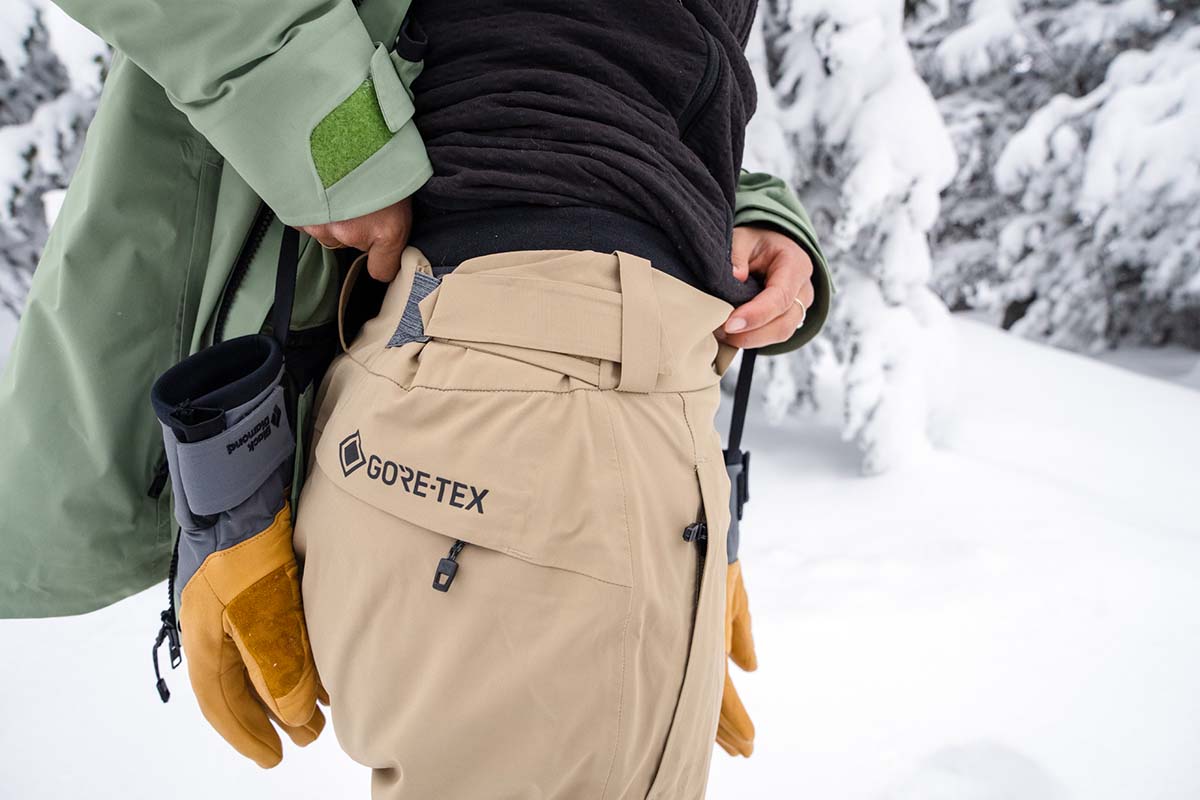
Durable Water Repellent (DWR) Finish
Another key component of a snowboard pant's wet-weather protection is its durable water repellent coating (DWR for short). This finish is added to the exterior fabric to keep the nylon or polyester material from absorbing moisture, which helps keep the waterproof membrane functioning properly—if too much water gets through the outer fabric, the membrane can get overwhelmed, which causes issues with breathability and even leakage. A properly functioning DWR is easy to spot: Snow and water will mostly stay on the surface of your pants and be easy to shake or brush off with your gloves. The DWR used in higher-end designs is most often higher-quality and longer-lasting, while you might find yourself needing to refresh the finish of a pant like the budget 686 Standard more often (regularly applying a product like Nikwax TX.Direct will do the trick).
Seam Taping
Assembling a pant requires connecting multiple pieces of fabric, which leaves potential vulnerabilities for moisture to seep through. By applying tape to the interior lining and seams, companies can provide an effective and mostly watertight seal. Pants in the mid and high end of the market often boast full seam taping, while budget-oriented models like the Volcom Freakin Snow Chino and Burton Covert 2.0 only protect the “critical” seams (areas most prone to moisture, such as the rear). Finally, the quality of the taping can vary—Gore-Tex taping has a long lifespan, while cheaper varieties can peel back or even partially disintegrate over time.
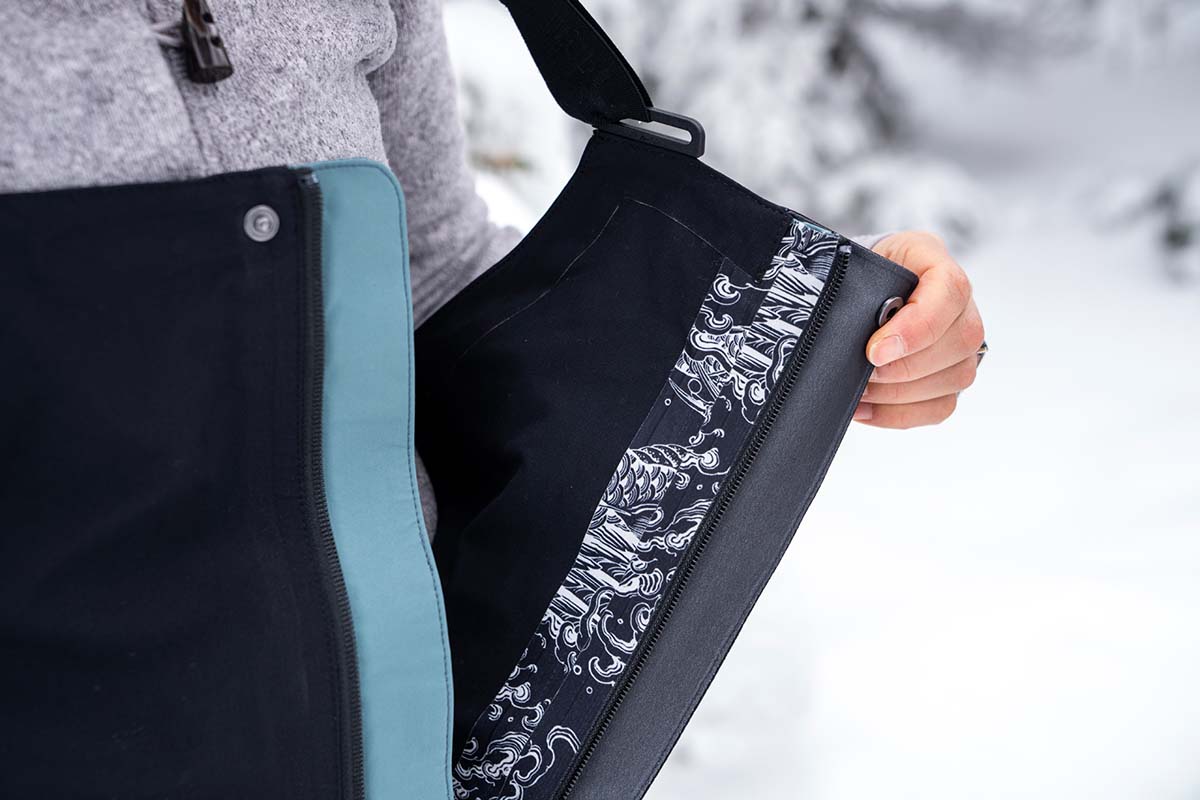
For most lift-assisted snowboarding, breathability is not a top consideration. As long as you’re not overdoing it with insulation and sticking to groomers or shorter runs in the trees, most pants are breathable enough to keep you comfortable. To help, each of the models above features at least two vents (one on each leg), which can be helpful for dumping heat on warmer days.
But for active riders or those who like to hike into the sidecountry, breathability jumps up the priority list. From the picks above, the best ventilators are non-insulated and feature premium 3-layer constructions, which keep air flowing a lot better than 2-layer designs (more on this below). Manufacturers will even take it a step further for backcountry use: For example, the Outdoor Research Skytour AscentShell Bibs use a stretchy 3-layer fabric almost akin to a softshell, and the Flylow Baker Bibs feature a membrane that's specifically built for air permeability. And then there are designs like the Jones Shralpinist Stretch Recycled Bibs, which use ultra-breathable softshell material on the bib where weather protection matters less. In the end, there’s no shortage of options for snowboarders who need a breathable pant—but expect the price to go up alongside performance.
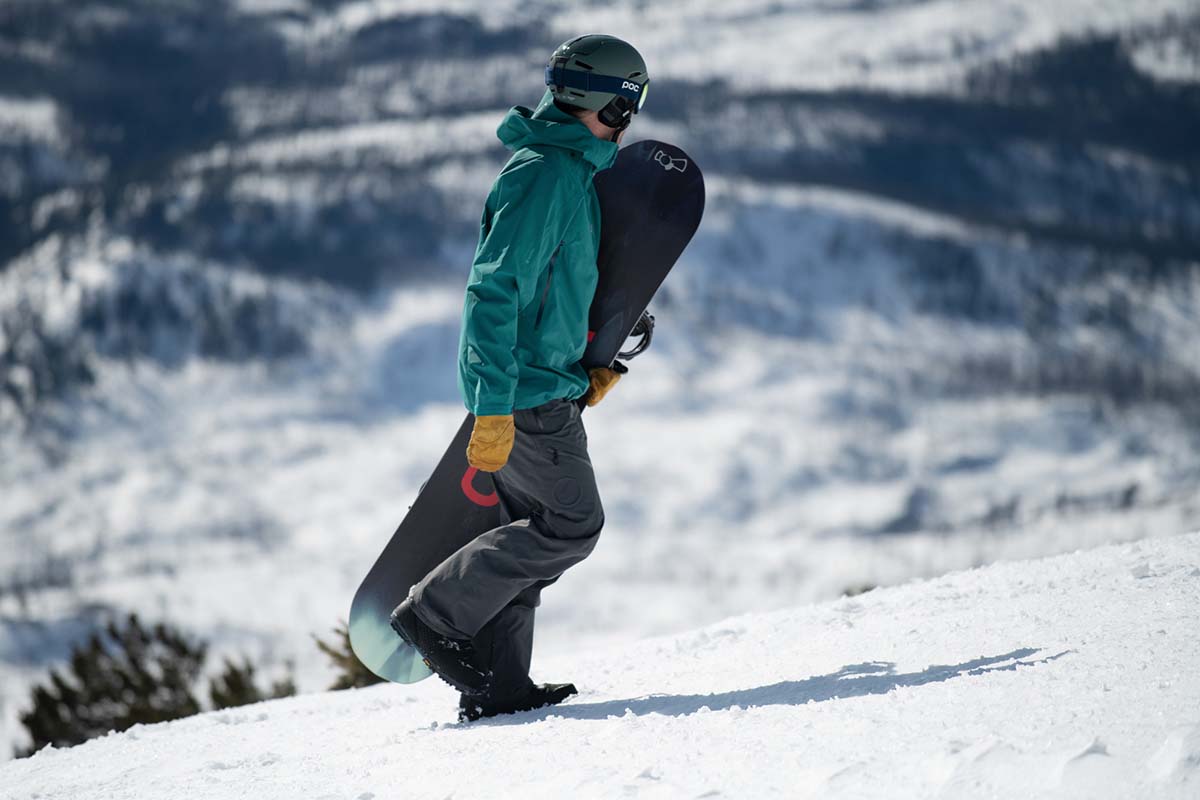
You’ll see a lot of references to 2-layer and 3-layer constructions above, and the distinction is an important one. Most snowboard pants feature a 2-layer build, which consists of the shell fabric and a waterproof/breathable membrane. Importantly, manufacturers will then add a hanging mesh or taffeta liner in order to protect the membrane from your skin. In a 3-layer build, this liner is streamlined and affixed to the inside of the waterproof/breathable membrane—hence the third layer. The end result is that 2-layer designs are inherently bulkier and don’t dump heat quite as well, while 3-layer pants are typically more unencumbered, lighter-weight, and more breathable.
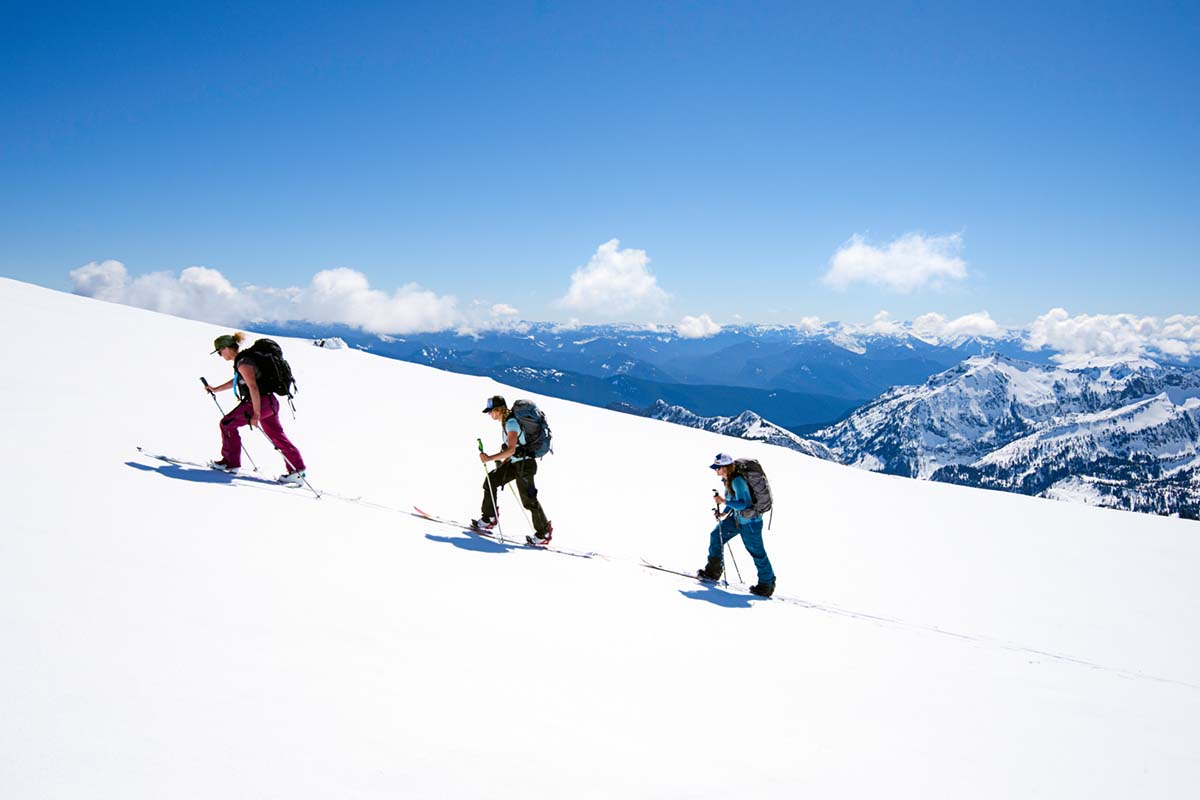
But despite the clear advantages of a 3-layer pant, 2-layer designs are fully serviceable for most recreational riders and comprise the majority of our list above. In short, the added performance of a more premium pant will be overkill in most resort applications and simply isn’t worth the jump in price. However, if you’re a serious rider, get out a lot, or dip into the backcountry from time to time, consider bumping up to a 3-layer pant.
Snowboard pants are a durable bunch, relying on substantial face fabrics to fend off harsh weather and rough use around chairlifts, park features, and sharp gear. However, not all snowboard apparel brands provide a fabric denier spec (a measurement of density and thickness), so it can be hard to compare models without seeing them in person. That said, designs fall into fairly predictable categories: Entry-level and mid-range pants are often quite tear-resistant and tough, using thick materials to provide a boost in weatherproofing (the Burton Reserve GTX Bibs feature 150D shells). Moving up, we see higher-end materials that are lighter but still durable, such as the Burton Cyclic’s 70-denier build. Backcountry-focused pants sacrifice a little durability for less weight and improved range of motion and breathability, but we’ve found even models like the Outdoor Research Skytour (40D x 65D) are reliably tough.
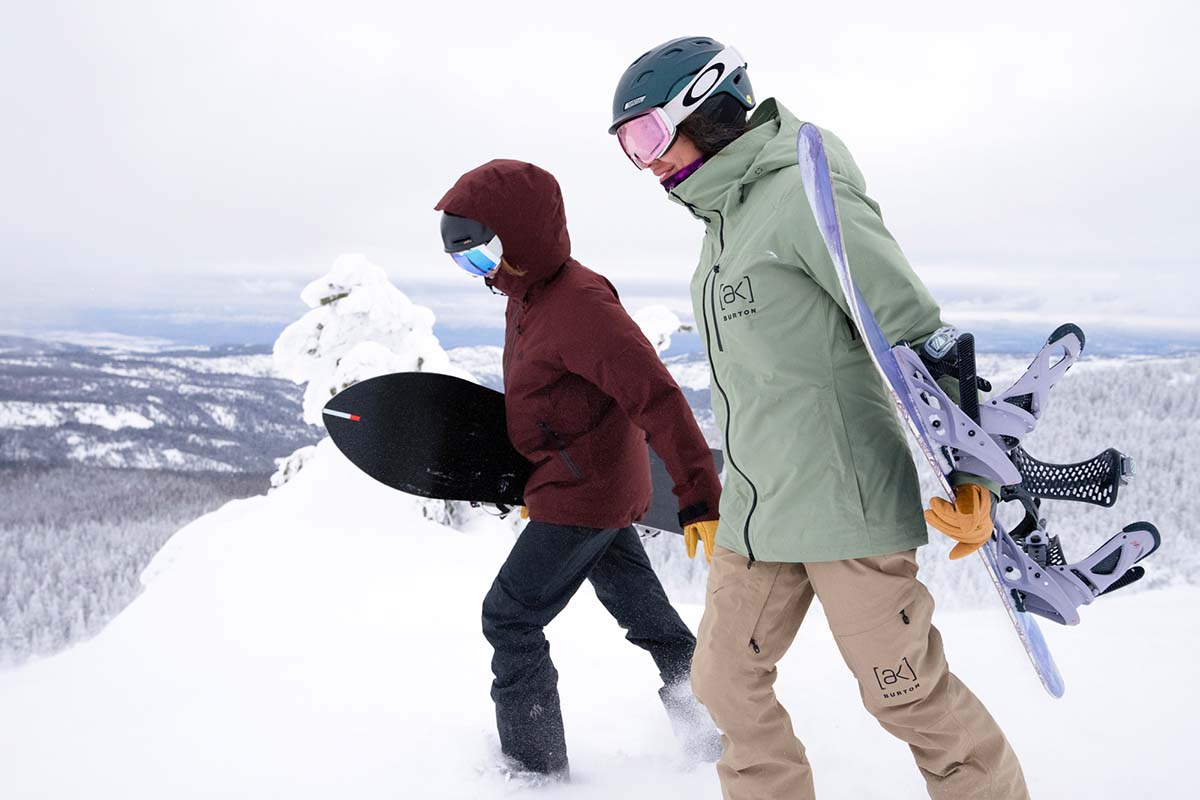
Closely tied to durability is weight: A thicker and very tough snowboard pant will logically weigh more. In addition, weight correlates with the categories we’ve listed above: shells are the thinnest and lightest, while insulated models will feel much heavier. Further, 2-layer designs often weigh more than 3-layer designs due to the added heft of the hanging liner. For most resort uses, weight is only a small consideration. While it’s nice to reduce bulk, many resort riders are perfectly content with a moderately heavy design. But if you’ll be hitting the backcountry or even spending a fair amount of time off-trail, a lighter shell pant will provide a nice boost in mobility and all-around comfort.
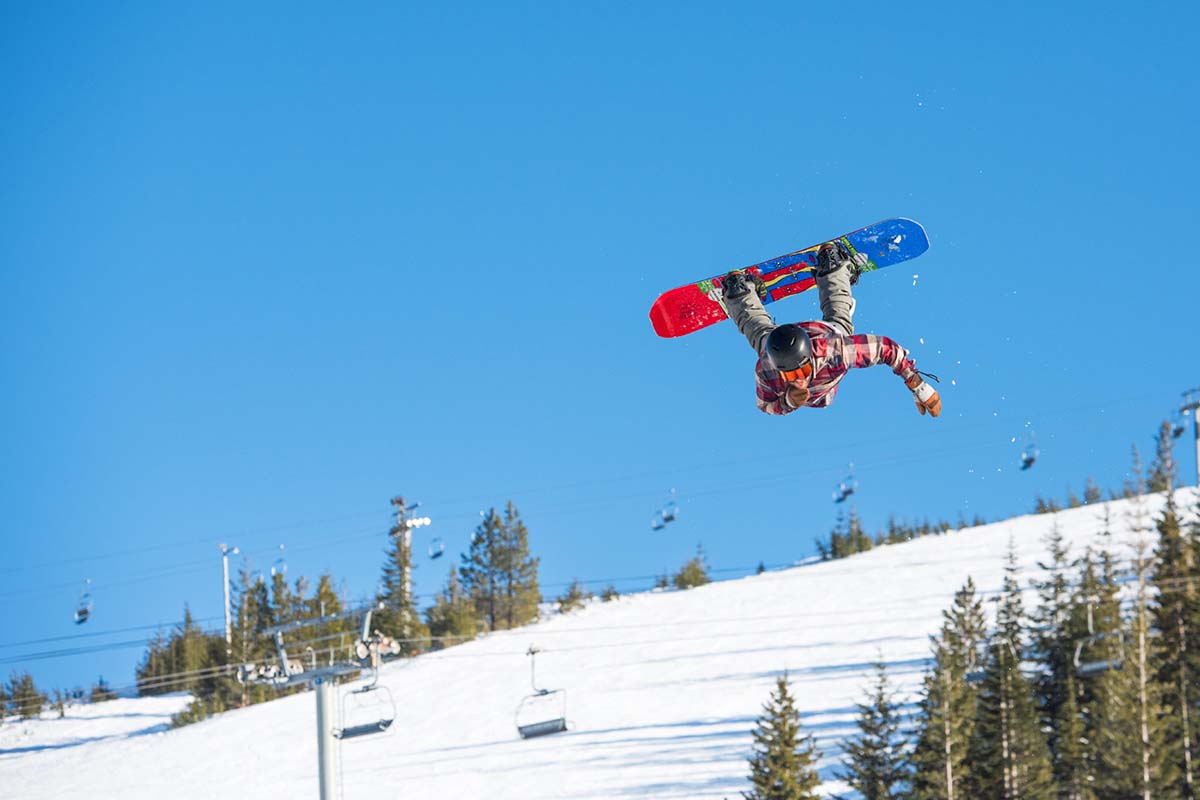
Pockets
Pockets are a significant style component of many snowboarding designs, which often include a range of rear, cargo, thigh, and handwarmer storage. Despite the myriad options, we recommend against packing these pockets full, as filling them with larger items can feel ungainly and restrict movement. Pants that have crossover appeal between snowboarding and skiing typically boast simplified layouts, but they'll often include at least a few zippered pockets for stashing personal items and snacks. Finally, backcountry-specific models like the Outdoor Research Skytour put a greater emphasis on quality and functionality over quantity, with dedicated storage for items like an avalanche beacon and extras like a map or GPS device.
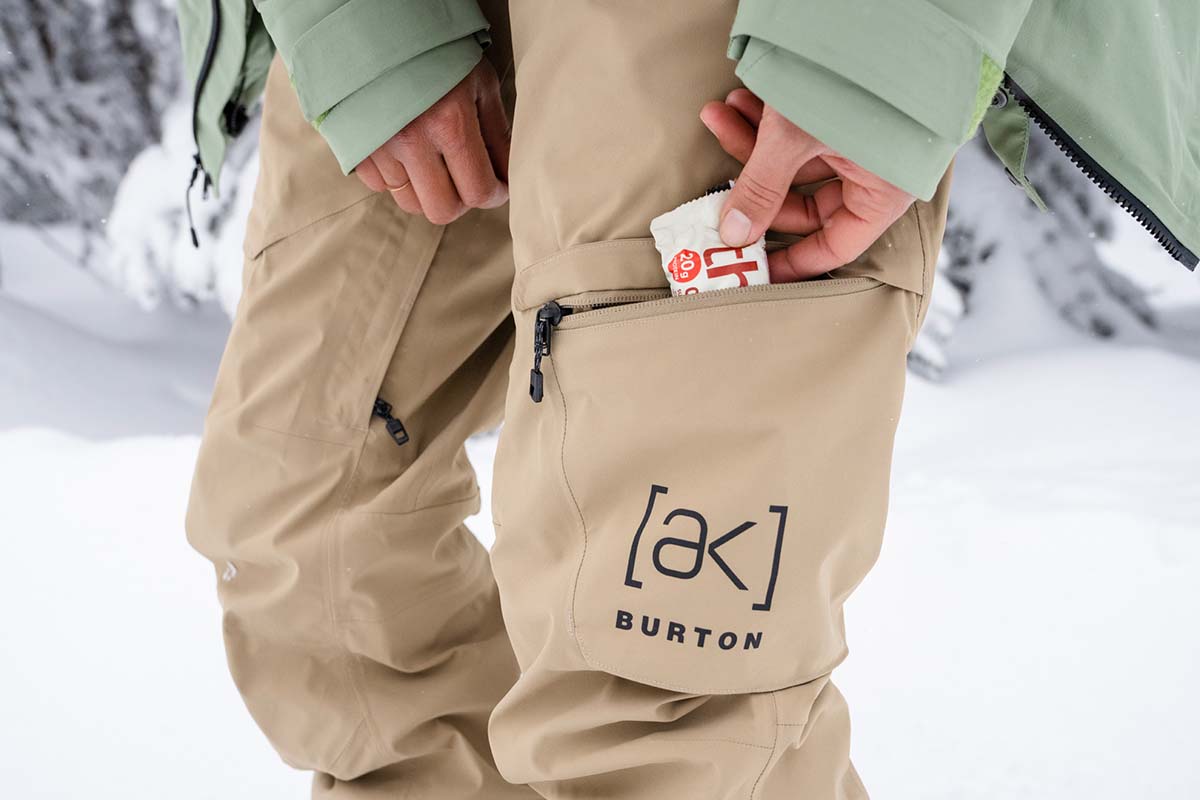
Ventilation
To aid in breathability, the vast majority of snowboard pants use a zippered ventilation system (essentially pit zips for your legs). The most common locations for the zippered panels are along the inside or outside of your thighs. We’ve found that outer-thigh vents do a better job dumping heat, while those on the inner thigh add unwanted bulk and can occasionally impact comfort (on the bright side, they are less conspicuous). Finally, designs like the 686 Gore-Tex Stretch Dispatch Bib and Flylow Gear Chemical have vents on both sides of the legs, which provides excellent cross ventilation.
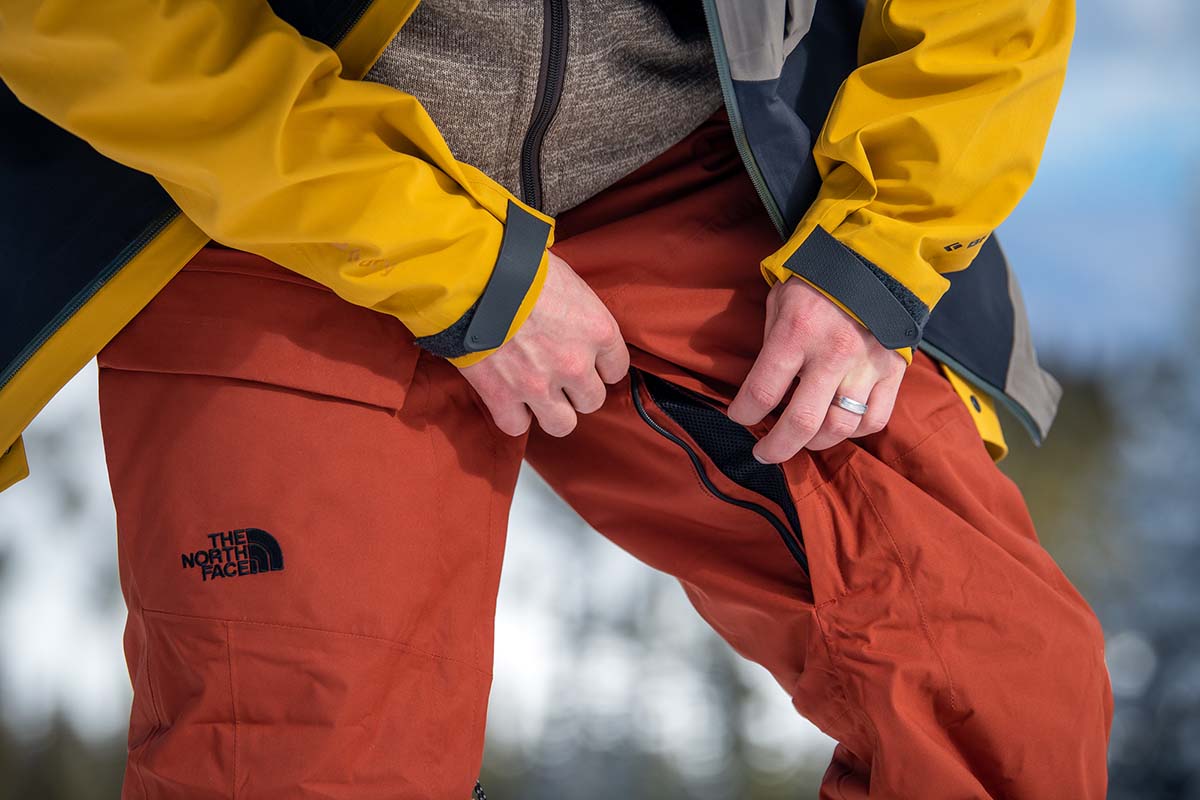
Jacket-to-Pant Attachment Systems
Let’s face it: wipeouts happen, regardless of your skill level. And if you’ve had the pleasure of experiencing a tumble on the slopes, you know that snow is adept at finding its way into the crevices of your jacket or pants. To help prevent this, some manufacturers place a button or loop on the jacket’s powder skirt to connect it to a corresponding attachment on the pants, forming a solid seal from the wet and cold. In the case of Volcom’s Zip Tech (as seen on the Freakin Snow Chino and L Gore-Tex pants), you get a full wraparound zip. Being able to attach your jacket to your pant is certainly not a required feature for either resort or backcountry use, but it's a nice addition for many. It’s worth noting that in nearly all cases, you’ll need to purchase a jacket from the same brand for the system to work and integrate properly.
Cuff Reinforcements and Risers
It’s no secret that most snowboarders like to wear their pants low, which can often result in torn cuffs from sharp edges over time. To remedy the issue, manufacturers reinforce the cuffs—often through the use of thicker fabrics or even silicone—and sometimes even provide a way for you to raise the cuffs to keep them from dragging through the parking lot or lodge. This is often done via a cinch near the ankle or extending up the backside of the leg (Burton has nicknamed them bungee cuff elevators and Picture Organic calls it their I-Fit System). If you like the look of baggy pants but want to minimize holes at the hem, it’s a good idea to look for one or both of these features.
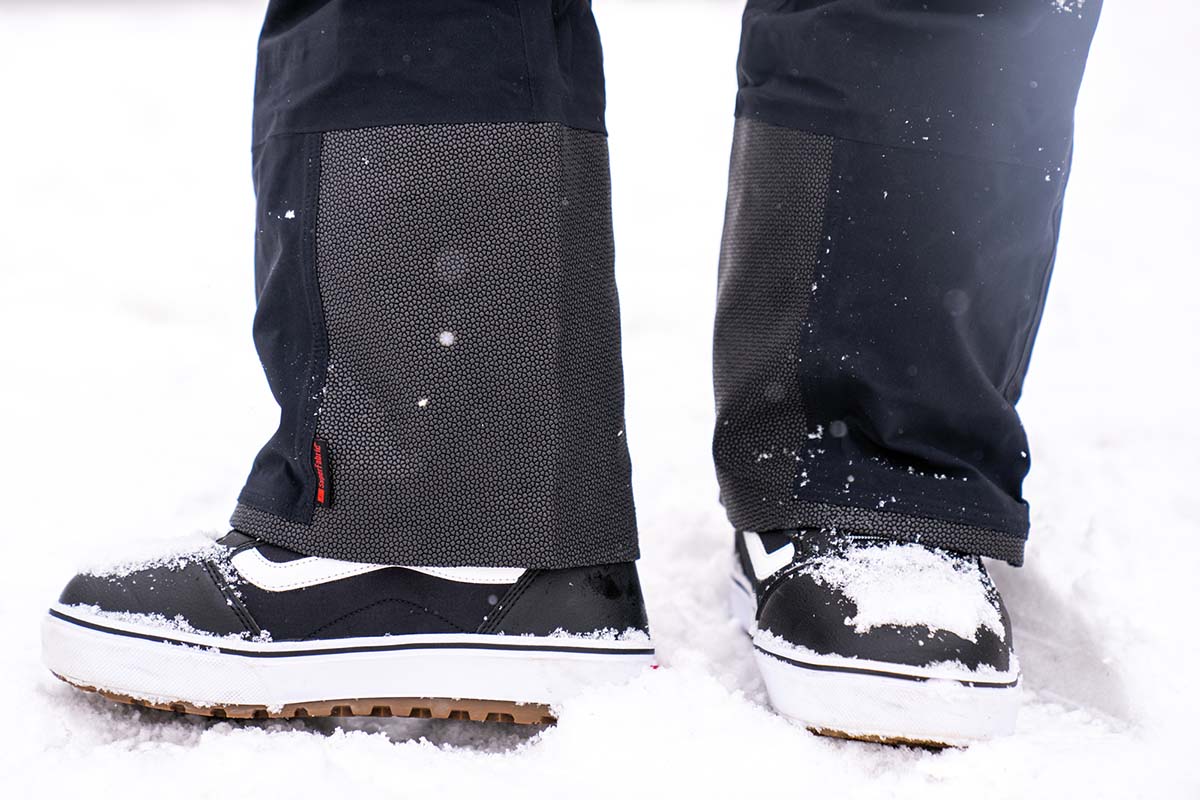
Another “either-or” decision when choosing snowboard pants is whether to opt for regular pants or a bib. Pants are the traditional choice and what most folks are familiar and comfortable with. They’re completely capable of all forms of riding and are much easier to slip on and off. The primary downside is felt when cold air or moisture finds its way up your back on the chairlift or after taking a fall.
Bibs are the remedy for these maladies as they offer better protection from the snow, wind, and wet. They also run a little warmer thanks to the extra layering that covers part of your upper body, which can be both a pro and a con. While you don’t have to worry about any discomfort from a waistband, the straps that run over your shoulders can take some getting used to, and you’ll need to dial in the fit to keep a bib from moving around excessively or pulling the pant legs up too high (we appreciate bibs that come short, regular, and tall inseams for this reason). And if you can’t decide, pants like Picture Organic’s Object offer a nice middle ground—the high waist keeps out snow without the added fabric and inconvenience of a bib.
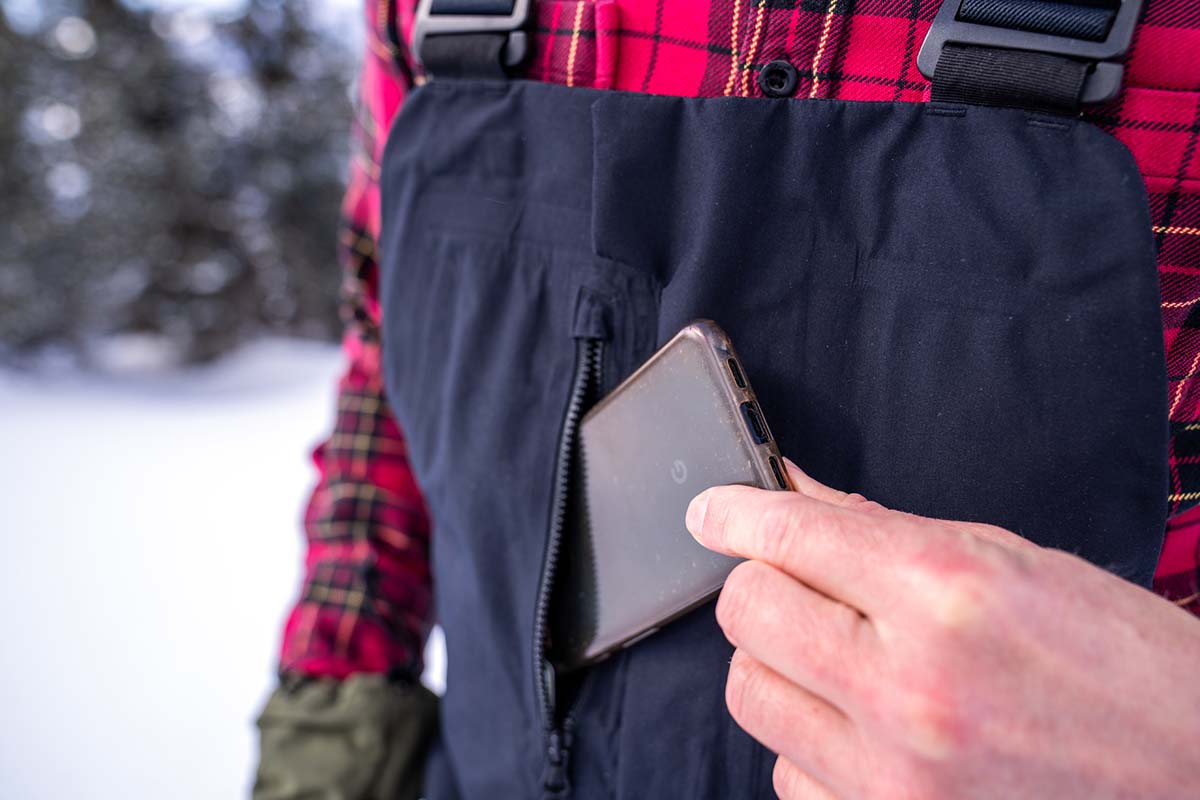
Snowboard pants are known for having fairly large and baggy fits—and this holds true for a lot of the market—although there are a growing number of designs with trimmer cuts that reduce bulk. Most park rats prefer extra space to maximize range of motion and limit pinch points (and style undeniably plays a role), while riders that seek out sidecountry lines typically like a streamlined, sleeker shape (often referred to as a “standard” or “regular” fit). When choosing a pant, it’s important to also think through the thickness of your layers underneath to avoid any binding and comfort-related problems.
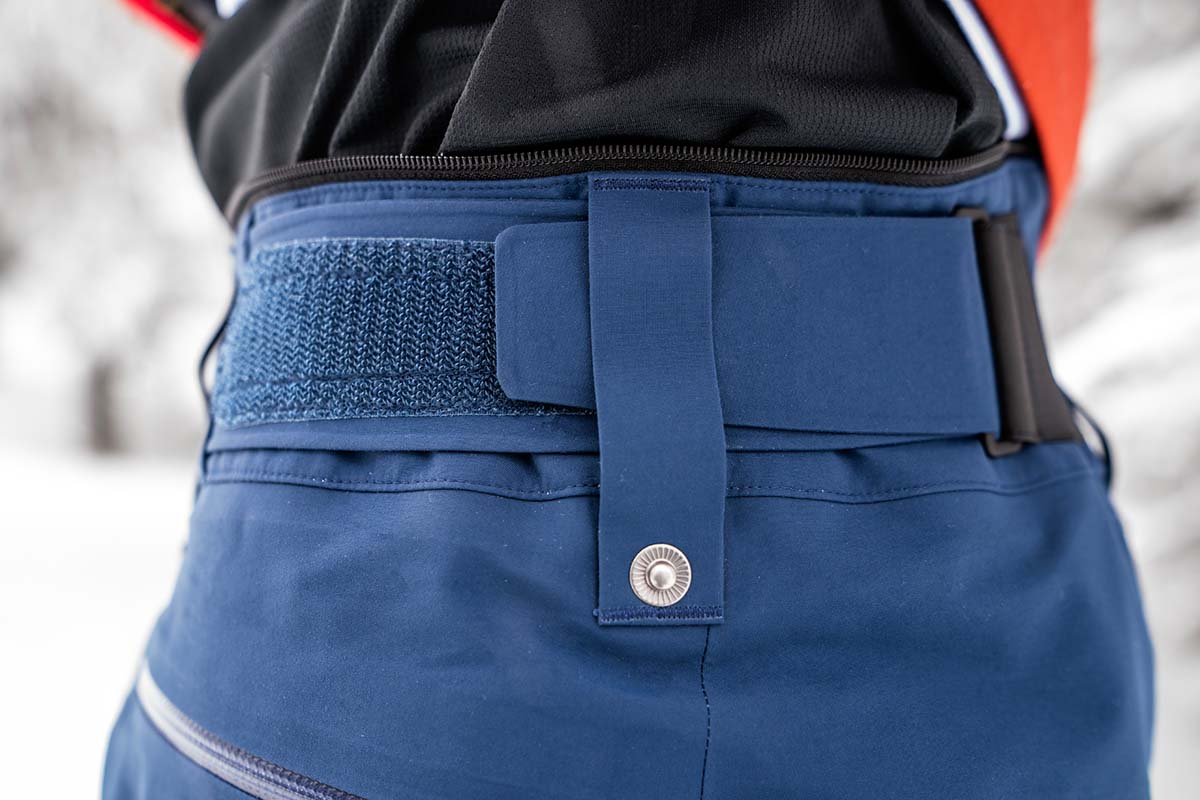
The layers you wear under your snowboard pants don’t get as much attention as those warming your core, but they nevertheless remain an important consideration. To start, it’s almost always a good idea to throw on at least a thin pair of long underwear. The extra layer not only provides insulation and protection from cold snow and freezing chairlift seats, but it also wicks moisture away from your skin. Further, the interiors of snowboard pants (especially uninsulated designs) are often not very plush, with exposed mesh, zippers, and minimalist liners that become less comfortable as the day wears on.
In choosing a baselayer, it’s worth getting a soft and close-fitting design to maximize warmth. The best models are made with either synthetic or merino wool—cotton doesn’t insulate when wet, so it’s a bad idea even on a resort day. Synthetics are the cheaper option and efficiently wick moisture, but merino wool is our favorite. It’s very warm for its weight, cozy and soft, and naturally resists odor better than a polyester alternative. Baselayers are offered in a range of thicknesses, including lightweight designs for warm days or backcountry use, as well as mid- and heavyweight options for cold days at the resort. And in particularly frigid conditions, you can always double up your baselayers or add a fleece pant to increase warmth.
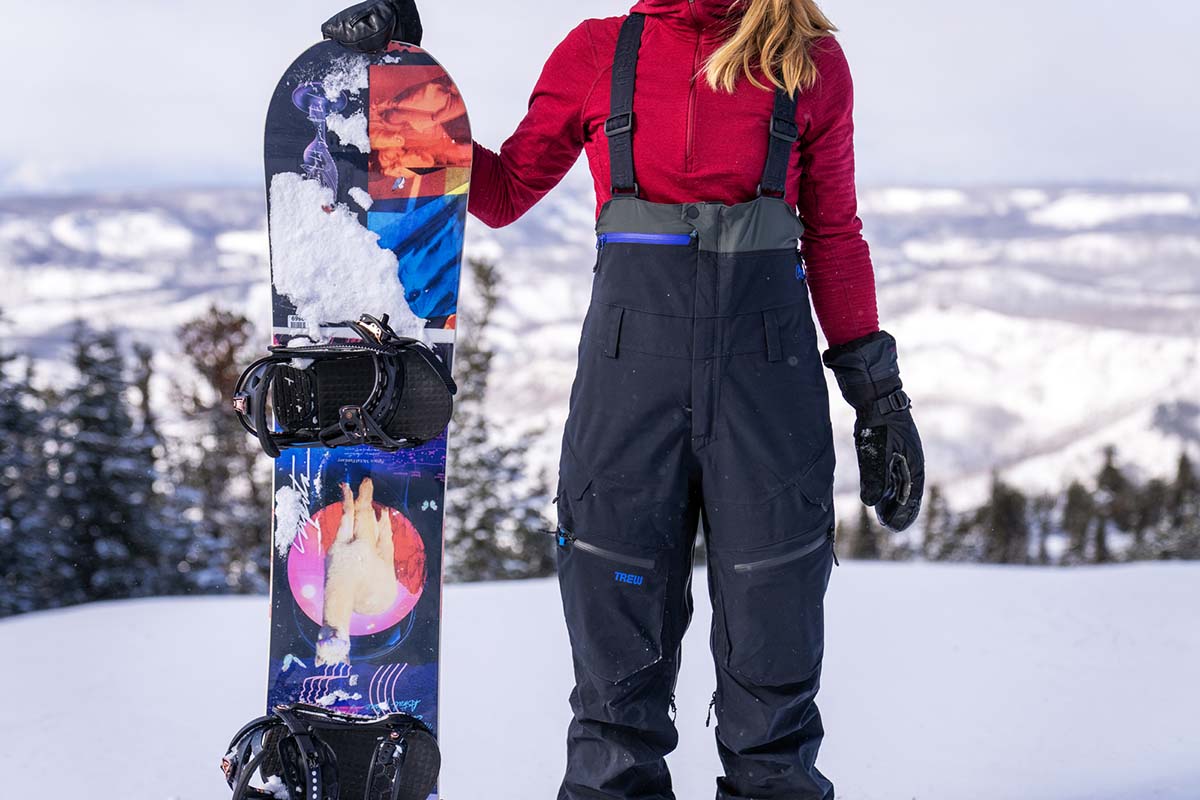
The outdoor apparel world has seen a sizable uptick in the use of sustainable practices in recent years, and snowboard jackets are no exception. Two key measures include recycled materials and PFAS-free DWR coatings (traditional coatings use per- or polyfluorinated chemicals—"forever chemicals" known to be harmful to the environment). With many states stepping up to ban the sale of items that include PFAS, the outdoor industry is seeking better solutions for water- and stain-resistant finishes (for more, you can read about Patagonia’s take on the issue). Bluesign-approved fabrics are also becoming more common, indicating that materials have been sourced and produced in ways that mitigate harmful impacts on the environment. Finally, many companies tack on a Fair Trade certification, which helps ensure the fair and ethical treatment of workers.
The good news is that most sustainability-conscious brands are transparent about these practices and clearly indicate which (if any) measures each product uses. Patagonia is an irrefutable leader in this realm: Their Powder Town Pants, for example, are Fair Trade Certified and use 100%-recycled and PFAS-free Gore-Tex ePE, as well as a partially recycled lining and PFAS-free DWR finish. Several other brands are making similar progress, including Burton, Picture Organic, Jones, and more. There’s still a long way to go in the industry, but the current trajectory and momentum from many of the key players is encouraging. And, of course, a final way to shop sustainably is to purchase quality products that will last and repair old gear rather than buy cheap items that will need to be replaced in a season or two.
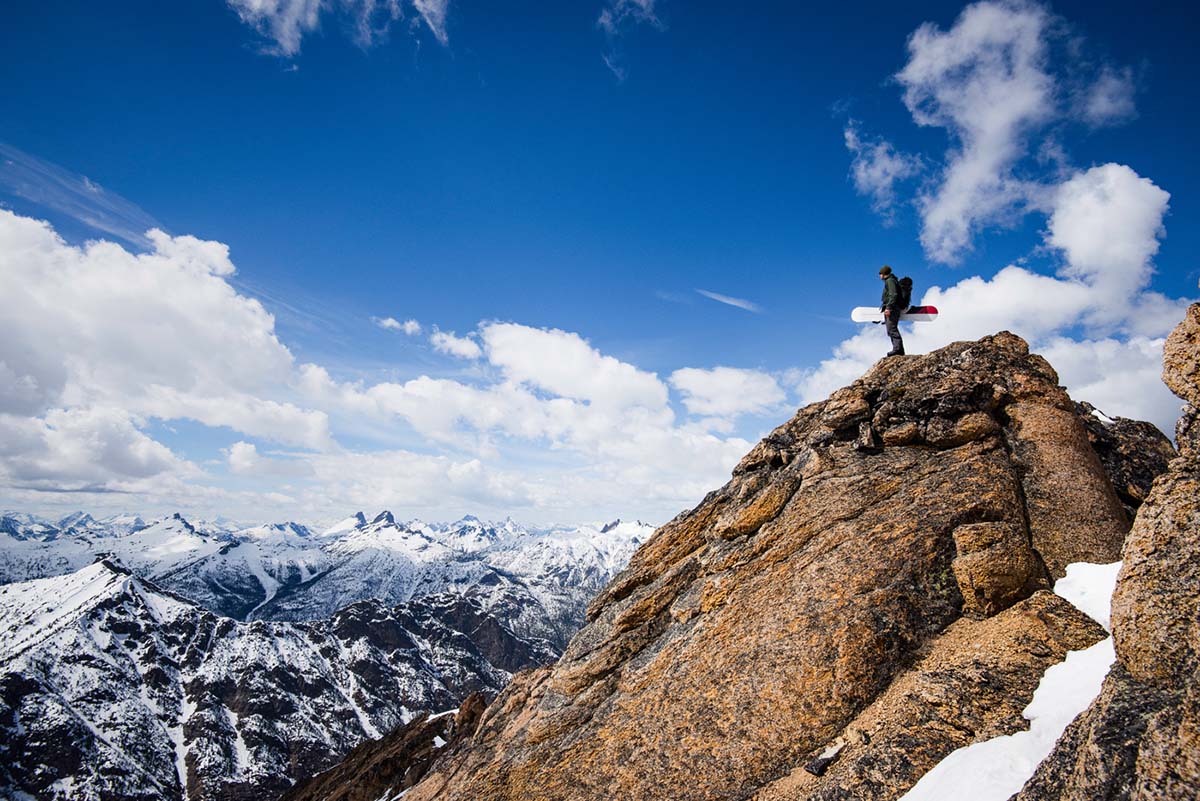
Given the similarities between the two sports, it’s not surprising that many ski pants and ski bibs are perfectly capable for snowboarding (and vice versa). In fact, you’ll see a lot of crossover in products when searching on a manufacturer or retailer site, and brands like Patagonia and Outdoor Research specifically state their pants are intended for both activities.
That said, snowboarding pants do differ slightly in terms of fit and features: In general, snowboarders prefer a looser cut with more pockets and style components. It’s also common to see boot gaiters (short zippers at the hem to create a flare around the boot) rather than scuff guards due to the nature of a snowboarder’s feet being separated on the board. Further, some pants feature a system that pulls the cuff up so it doesn’t drag when walking through the parking lot or the lodge. But in most cases, these are largely cosmetic differences with little impact on overall performance, and you’ll ultimately want to choose the style that appeals to you most.
Back to Our Snowboard Pant Picks Back to Our Snowboard Pant Comparison Table